Performance Analysis of the Developed Air Source Heat Pump System at Low-to-Medium and High Supply Temperatures for Irish Housing Stock Heat Load Applications
Abstract
:1. Introduction
1.1. Literature Review
1.2. Research Gaps and Contribution of This Work
2. Methodology
2.1. Heat Pump Characterizations
2.2. The Control Devices and Data Acquisition System
2.3. Experimental Procedure and Test Conditions
2.4. Domestic Heat Load Demands for Irish Housing Stock
2.5. Mathematical Formulae
2.5.1. Model Validation with Testing Results
2.5.2. HP Part Load Performance
3. Results Analysis and Discussions
3.1. HP Testing Results at Low-to-Medium and High Heat Supply Temperature
3.2. Part Load Performance for the Five Property Types with a Single Age Period (1900–1949)
3.3. Electric Power Consumption and Heating Production Difference (FSM vs. VSM)
3.4. Annual Performance for Five Property Types (1900–1949)
3.5. Payback Period Analysis
3.6. Summary Result for Five Property Types with Four Age Periods
3.6.1. Annual COPs
3.6.2. Energy Consumption
3.6.3. Performance Improvement with Operating Mode of Operation (VSM vs. FSM)
4. Conclusions
- (a)
- The annual performance is improved with the VSM of control in comparison to the FSM of control, but at the cost of higher initial cost associated with control devices. The payback period for additional control devices was 2.8 years at the lower heat supply temperature of 35 °C (C1), and increase to 3.7 years at the higher heat supply temperature of 55 °C (C3). The VSM of control for capacity adjustment is more beneficial in terms of the annual COP due to the match between the load demand and heat supplied compared to the FSM. This was also reported in the literature [55,56].
- (b)
- Among the considered cases (C1, C2, C3) and all property types with different age periods, a maximum energy savings (VSM vs. FSM) of up to 61% was possible with the flats type (C1) with the age period of 1991–2007 onwards. The reason was the lower speed operation of the system below the nominal value and the increased cycling losses in FSM.
- (c)
- The lower heat supply temperature has a significant impact on the annual performance improvement for all property types. The COP improvement with the HP (VSM) of up to 54% and energy savings of 35% was possible due to the control mode for the flats type (1900–1949) at the lower supply temperature. The respective improvement with the COP and energy reduced to 34% and 25%, respectively, during the FSM.
Author Contributions
Funding
Institutional Review Board Statement
Informed Consent Statement
Data Availability Statement
Conflicts of Interest
Abbreviations
| ASHP | air source heat pump |
| COP | coefficient of performance (-) |
| CO2 | carbon dioxide (-) |
| C1 | case study 1 (35 °C fixed heat supply temperature) |
| C2 | case study 2 (45 °C fixed heat supply temperature) |
| C3 | case study 3 (55 °C fixed heat supply temperature) |
| DB | dry bulb temperature (°C) |
| SCOP | seasonal coefficient of performance (-) |
| DB | dry bulb (°C) |
| EH | electric heater requirements (KWh) |
| EIR | electric input ratio (−) |
| EWT | entering water temperature (°C) |
| FSM | fixed speed mode (-) |
| PLF | part load factor (−) |
| PLR | part load ratio (−) |
| RMSE | root-mean-square error |
| VSM | variable speed mode (-) |
| WST | water supply temperature (°C) |
| WB | wet bulb (°C) |
| RH (%) | relative humidity (-) |
| PID | proportional integral derivative |
| RPM | revolution per minute |
| HD | heat demand (kW) |
| HC | heating capacity (kW) |
| A2W35 | ambient temperature of 2 °C with water temperature of 35 °C |
| Symbols | |
| water specific heat capacity (kJ/kg·K) | |
| heating capacity (kW) | |
| refrigerant mass flow rate (kg/s) | |
| pressure ratio (-) | |
| ambient temperature (°C) | |
| water mass flow rates (kg/s) in a closed circuit | |
| difference between supplied and entering water temperature to the HP | |
| isentropic efficiency (%) | |
| volumetric efficiency (%) | |
| refrigerant specific volume at the compressor suction (m3·kg−1) | |
| swept volume (m3) | |
| enthalpy difference (kJ/kg) | |
| isentropic enthalpy (kJ/kg) | |
| total electric power consumption (kW) | |
| compressor electric power consumption (kW) | |
| auxiliaries power consumption (kW) | |
| Greek symbols | |
| relative humidity (%) | |
| density (kg/m3) | |
| frequency (Hz) |
References
- United Nations Environment Programme. Renewables 2020 Global Status Report. 2020. Available online: https://www.ren21.net/wp-content/uploads/2019/05/gsr_2020_full_report_en.pdf (accessed on 18 May 2021).
- European Parliament. EU Directive on the Energy Performance of Buildings (Recast) (2010/31/EU). 2010. Available online: https://ec.europa.eu/energy/topics/energy-efficiency/energy-efficient-buildings/energy-performance-buildings-directive_en (accessed on 18 May 2021).
- Department for Business, Energy and Industrial Strategy. Energy Consumption in the UK 2020. Available online: https://www.gov.uk/government/statistics/energy-consumption-in-the-uk (accessed on 18 May 2021).
- Department of Energy and Climate Change. Provisional Estimates of UK Greenhouse Gas Emissions for 2015, Including Quarterly Emissions for 4th Quarter 2015. Available online: https://www.gov.uk/government/statistics/provisional-uk-greenhouse-gas-emissions-national-statistics-2015 (accessed on 24 September 2020).
- Druckman, A.; Jackson, T. Household energy consumption in the UK: A highly geographically and socio-economically disaggregated model. Energy Policy 2008, 36, 3177–3192. [Google Scholar] [CrossRef] [Green Version]
- Emissions from Heat. Technical Report, Department of Energy and Climate Change. Available online: https://www.gov.uk/government/statistics/uk-emissions-from-heat (accessed on 27 July 2020).
- Net Zero by 2050: A Roadmap for the Global Energy System. Available online: https://www.iea.org/events/net-zero-by-2050-a-roadmap-for-the-global-energy-system (accessed on 5 October 2021).
- Parliament of the United Kingdom. Climate Change Act (2008). Available online: http://www.legislation.gov.uk/ukpga/2008/27/pdfs/ukpga_20080027_en.pdf (accessed on 21 May 2019).
- CCC Net Zero. The UK’s Contribution to Stopping Global Warming. 2019. Available online: https://www.theccc.org.uk/publication/net-zero-the-uks-contribution-to-stopping-global-warming/ (accessed on 18 May 2021).
- GOV.UK. Spring Statement 2019: What You Need to Know—GOV.UK 2019. Available online: https://www.gov.uk/government/news/spring-statement-2019-what-you-need-to-know (accessed on 18 May 2021).
- Carroll, P.; Chesser, M.; Lyons, P. Air Source Heat Pumps field studies: A systematic literature review. Renew. Sustain. Energy Rev. 2020, 134, 110275. [Google Scholar] [CrossRef]
- Jeter, S.M.; Wepfer, W.J.; Fadel, G.M.; Cowden, N.E.; Dymfk, A.A. Variable speed drive heat pump performance. Energy 1987, 12, 1289–1298. [Google Scholar] [CrossRef]
- Madani, H.; Claesson, J.; Lundqvist, P. Capacity control in ground source heat pump systems part II: Comparative analysis between on/off controlled and variable capacity systems. Int. J. Refrig. 2011, 34, 1934–1942. [Google Scholar] [CrossRef]
- European Standard EN 14511-3—Air Conditioners, Liquid Chilling Packages and Heat Pumps with Electrical Driven Compressors for Space Heating and Cooling-Part 3, Test Methods. 2018. Available online: https://www.iea.org/policies/7031-en-14511-22018-test-methods-and-standards-for-air-conditioners-liquid-chilling-packages-and-heat-pumps (accessed on 27 July 2020).
- Bundesamt für Wirtschaft und Ausfuhrkontrolle. Erneuerbare Energien Wärmepumpen mit Prüfnachweis; Technical Report; Bundesamt für Wirtschaft und Ausfuhrkontrolle: Eschborn, Germany, 2016.
- Qureshi, T.Q.; Tassou, S.A. Variable-speed capacity control in refrigeration systems. Appl. Therm. Eng. 1996, 16, 103–113. [Google Scholar] [CrossRef]
- Wong, A.K.H.; James, R.W. Capacity control of a refrigeration system using a variable speed compressor. Build. Serv. Eng. Res. Technol. 1988, 9, 63–68. [Google Scholar]
- Wong, A.K.H.; James, R.W. Influence of control systems on the performance of refrigeration systems. Aust. Refrig. Air Cond. Heat. 1989, 43, 21–36. [Google Scholar]
- Tassou, S.A.; Qureshi, T.Q. Performance of a variable speed inverter/motor drive for refrigeration applications. Comput. Control Eng. J. 1994, 5, 193–199. [Google Scholar] [CrossRef]
- Tassou, S.A.; Marquand, C.J.; Wilson, D.R. The effects of capacity modulation on the performance of vapour compression heat pump systems. In Proceedings of the International Conference, Forward Swept Wing Aircraft, Bristol, UK, 24–26 March 1982. [Google Scholar]
- Munari, P.; Da Riva, E.; Del Col, D.; Mantovan, M. Energy efficiency of variable capacity ground source heat pumps. In Proceedings of the AS-Alternative Sources/ISPHC11-International Sorption Heat Pump Conference, Padua, Italy, 5–7 April 2011. [Google Scholar]
- Karlsson, F.; Fahlen, P. Improving efficiency of hydronic heat pump heating systems. In Proceedings of the 21st International Congress of Refrigeration, Washington, DC, USA, 17–22 August 2003. [Google Scholar]
- Karlsson, F.; Fahlen, P. Capacity—Controlled ground source heat pumps in hydronic heating systems. Int. J. Refrig. 2007, 30, 221–229. [Google Scholar] [CrossRef]
- Adhikari, R.S.; Aste, N.; Manfren, M.; Marini, M. Energy Savings through Variable Speed Compressor Heat Pump Systems. Energy Procedia 2012, 14, 1337–1342. [Google Scholar] [CrossRef] [Green Version]
- Miller, W.A. Laboratory examination and seasonal analyses of the dynamic losses for a continuously variable-speed heat pump. NASA STI/Recon Tech. Rep. N 1988, 94, 1246–1268. Available online: https://ui.adsabs.harvard.edu/#abs/1988STIN...8911174M/abstract (accessed on 27 July 2020).
- Tassou, S.A.; Qureshi, T.Q. Comparative performance evaluation of positive displacement compressors in variable-speed refrigeration applications. Int. J. Refrig. 1998, 21, 29–41. [Google Scholar] [CrossRef]
- Halozan, H. Inverter-driven heat pumps for hydronic systems. ASHRAE Trans. 1988, 1269–1278. Available online: https://heatpumpingtechnologies.org/publications/inverter-driven-heat-pumpsanalysis-of-heat-pump-units-and-systems (accessed on 18 May 2021).
- Lande, J. Tests on Air-To-Air Heat Pumps, with and without Inverter Control; Royal Institute of Technology: Stockholm, Sweden, 1992; Volume 92, p. 36. (In Swedish) [Google Scholar]
- Tassou, S.A.; Marquand, C.J. Comparison of the performance of capacity controlled and conventional on/off controlled heat pumps. Appl. Energy 1983, 14, 241–256. [Google Scholar] [CrossRef]
- Bergman, A. Impact of on/off Control of Heat Pumps Laboratory Testing; Byggforskningsrådet R111: Stockholm, Sweden, 1985; 67p. (In Swedish) [Google Scholar]
- Karlsson, F. Capacity Control of Residential Heat Pump Heating Systems. Ph.D. Thesis, Chalmers Tekniska Högskola, Göteborg, Sweden, 2007. [Google Scholar]
- Garstang, S.W. Variable frequency speed control of refrigeration compressors, Part 1. Air Cond. Heat.-Março 1990, 44, 21–23. [Google Scholar]
- Zhao, L.; Zhao, L.L.; Zhang, Q.; Ding, G.L. Theoretical and basic experimental analysis on load adjustment of geothermal heat pump systems. Energy Convers. Manag. 2003, 44, 1–9. [Google Scholar] [CrossRef]
- Karlsson, F.; Fahlen, P. Impact of design and thermal inertia on the energy saving potential of capacity-controlled heat pump heating systems. Int. J. Refrig. 2008, 31, 1094–1103. [Google Scholar] [CrossRef]
- Aprea, C.; Mastrullo, R.; Renno, C. Experimental analysis of the scroll compressor performances varying its speed. Appl. Therm. Eng. 2006, 26, 983–992. [Google Scholar] [CrossRef]
- Aprea, C.; Mastrullo, R.; Renno, C. Determination of the compressor optimal working conditions. Appl. Therm. Eng. 2009, 29, 1991–1997. [Google Scholar] [CrossRef] [Green Version]
- Cuevas, C.; Lebrun, J. Testing and modelling of a variable speed scroll compressor. Appl. Therm. Eng. 2009, 29, 469–478. [Google Scholar] [CrossRef]
- Madani, H.; Claesson, J.; Ahmadi, N.; Lundqvist, P. Experimental Analysis of a Variable Capacity Heat Pump System Focusing on the Compressor, and Inverter Loss Behaviour. In Proceedings of the International Refrigeration and Air Conditioning Conference, West Lafayette, IN, USA, 12–15 July 2010; Available online: https://docs.lib.purdue.edu/cgi/viewcontent.cgi?article=2062&context=iracc (accessed on 27 July 2020).
- Hewitt, N.J.; Huang, M.J.; Anderson, M.; Quinn, M. Advanced air source heat pumps for UK and European domestic buildings. Appl. Therm. Eng. 2011, 31, 3713–3719. [Google Scholar] [CrossRef]
- Quinn, M. The Development of a Capacity Controlled Advanced Cycle Air Source Heat Pump for Domestic Retrofit Applications. Ph.D. Thesis, Ulster University, Coleraine, UK, 2012. Available online: https://ethos.bl.uk/OrderDetails.do?did=1&uin=uk.bl.ethos.592665 (accessed on 27 July 2020).
- Abid, M.; Hewitt, N.; Huang, M.J.; Wilson, C.; Cotter, D. Experimental Study of the Heat Pump with Variable Speed Compressor for Domestic Heat Load Applications. In Proceedings of the 25th Compressor Engineering, Refrigeration, Air-Conditioning, and High-Performance Buildings, West Lafayette, IN, USA, 24–28 May 2021; Available online: https://docs.lib.purdue.edu/cgi/viewcontent.cgi?article=3677&context=icec (accessed on 29 May 2021).
- Abid, M.; Hewitt, N.; Huang, M.J.; Wilson, C.; Cotter, D. Heat Supply Temperature Impact on the Seasonal Cost of Low Carbon Domestic Heat Pump Technology. 2020. Available online: https://www.enerarxiv.org/page/thesis.html?id=2685 (accessed on 29 May 2021).
- Oughton, D.R.; Hodkinson, S.L.; Kell’s, F. Heating and Air-Conditioning of Buildings Tenth Edition; Elsevier: Amsterdam, The Netherlands, 2008; Available online: http://docshare04.docshare.tips/files/22696/226963577.pdf (accessed on 29 May 2020).
- Carbon Trust Report, August 2020. Heat Pump Retrofit in London. Available online: https://www.carbontrust.com/resources/heat-pump-retrofit-in-london (accessed on 30 March 2021).
- Klein, S.A.; Beckman, W.A.; Mitchell, J.W.; Duffie, J.A.; Duffie, N.A.; Freeman, T.L.; Mitchell, J.C.; Braun, J.E.; Evans, B.L.; Kummer, J.P.; et al. TRNSYS 17: A Transient System Simulation Program; Solar Energy Laboratory, University of Winsconsin: Madison, WI, USA, 2010. [Google Scholar]
- ASHRAE. Guideline 2-2010, Engineering Analysis of Experimental Data; ASHRAE: Atlanta, GA, USA, 1986; Available online: https://www.techstreet.com/standards/guideline-2-2010-ra-2014-180engineering-analysis-of-experimental-data?product_id=1873287 (accessed on 29 May 2020).
- Correa, F.; Cuevas, C. Air-water heat pump modelling for residential heating and domestic hot water in Chile. Appl. Therm. Eng. 2018, 143, 594–606. [Google Scholar] [CrossRef]
- Wolfram Research, Inc. Mathematica, Version 12.2; Wolfram Research, Inc.: Champaign, IL, USA, 2020. [Google Scholar]
- Madonna, F.; Bazzocchi, F. Annual performances of reversible air-to-water heat pumps in small residential buildings. Energy Build. 2013, 65, 299–309. [Google Scholar] [CrossRef]
- Cabrol, L.; Rowley, P. Towards low carbon homes—A simulation analysis of building-integrated air-source heat pump systems. Energy Build. 2012, 48, 127–136. [Google Scholar] [CrossRef] [Green Version]
- Kinab, E.; Marchio, D.; Riviere, P.; Zoughaib, A. Reversible heat pump model for seasonal performance optimization. Energy Build. 2010, 42, 2269–2280. [Google Scholar] [CrossRef]
- Dongellini, M.; Naldi, C.; Morini, G.L. Seasonal performance evaluation of electric air-to-water heat pump systems. Appl. Therm. Eng. 2015, 90, 1072–1081. [Google Scholar] [CrossRef]
- Mader, G.; Madani, H. Capacity control in air-water heat pumps: Total cost of ownership analysis. Energy Build. 2014, 81, 296–304. [Google Scholar] [CrossRef]
- Myers, M.; Kourtza, E.; Kane, D.; Harkin, S. The Cost of Installing Heating Measures in Domestic Properties; A Delta-EE Report for the Department for Business, Energy, and Industrial Strategy BEIS; London, UK. Final Report 2018; Research Paper Number: 2020/028; Delta Energy and Environment Ltd.: Edinburgh, UK, 2020. [Google Scholar]
- Szreder, M.; Miara, M. Impact of Compressor Drive System Efficiency on Air Source Heat Pump Performance for Heating Hot Water. Sustainability 2020, 12, 521. [Google Scholar] [CrossRef]
- Abid, M.; Hewitt, N.; Huang, M.-J.; Wilson, C.; Cotter, D. Domestic Retrofit Assessment of the Heat Pump System Considering the Impact of Heat Supply Temperature and Operating Mode of Control—A Case Study. Sustainability 2021, 13, 10857. [Google Scholar] [CrossRef]
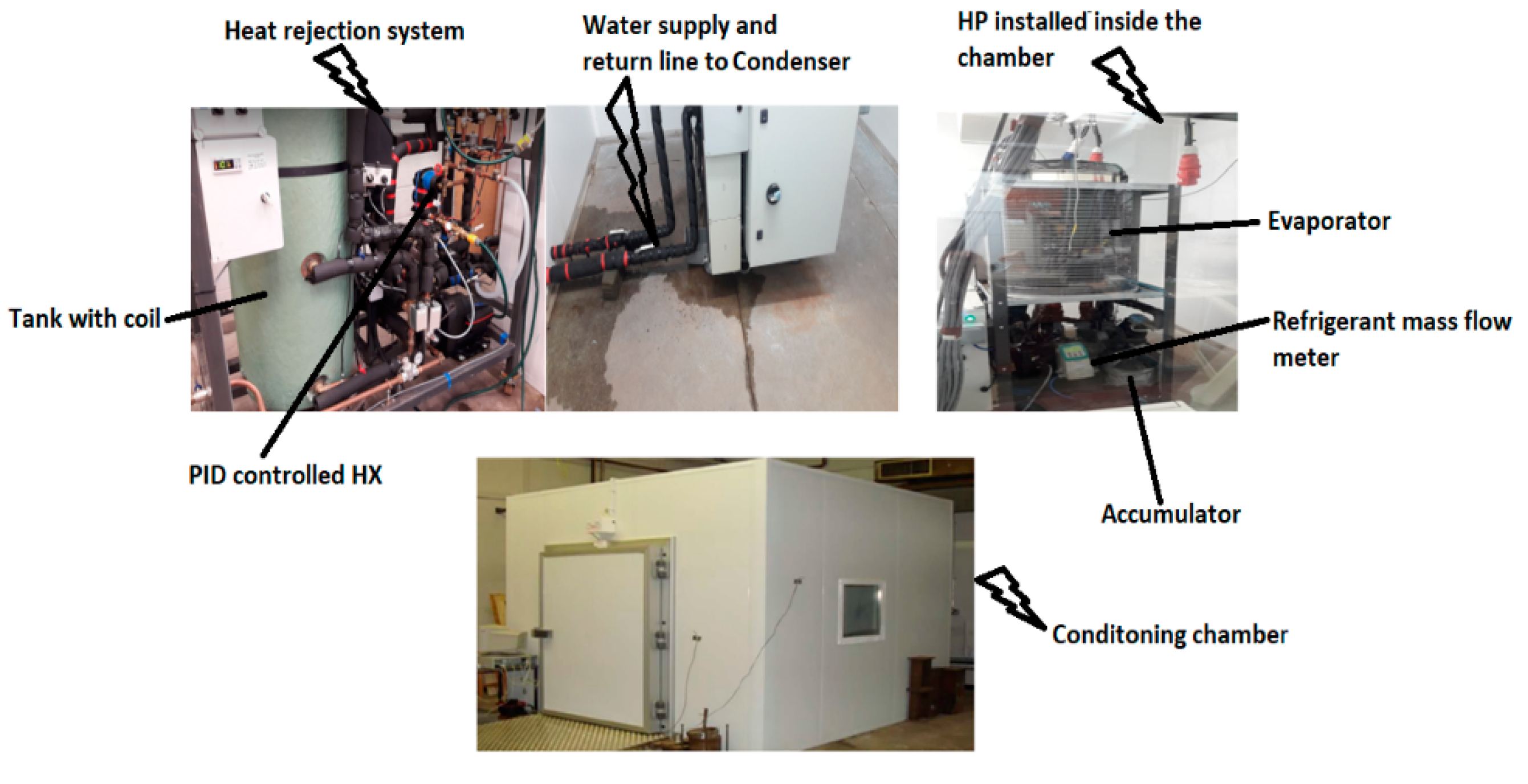
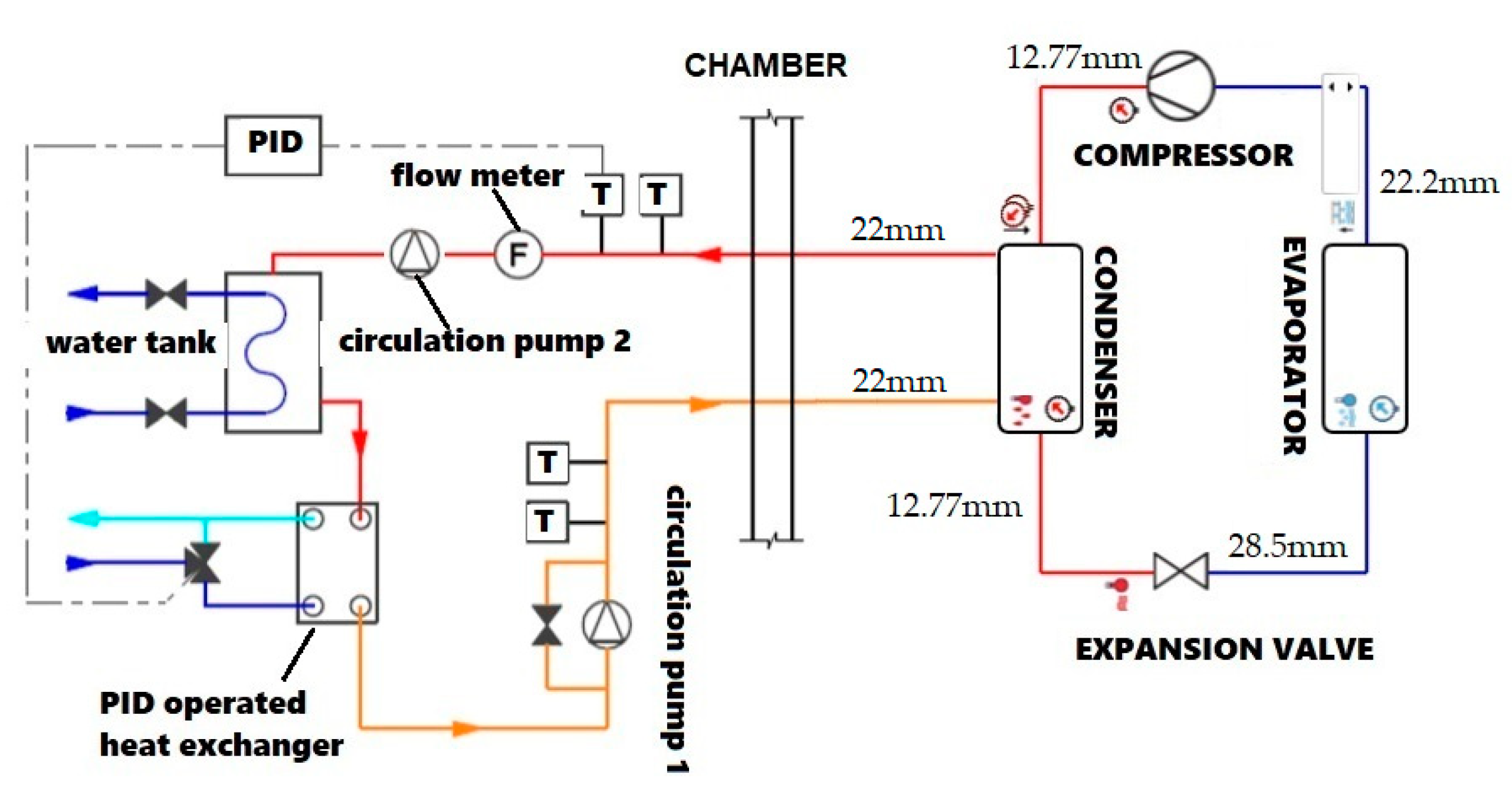
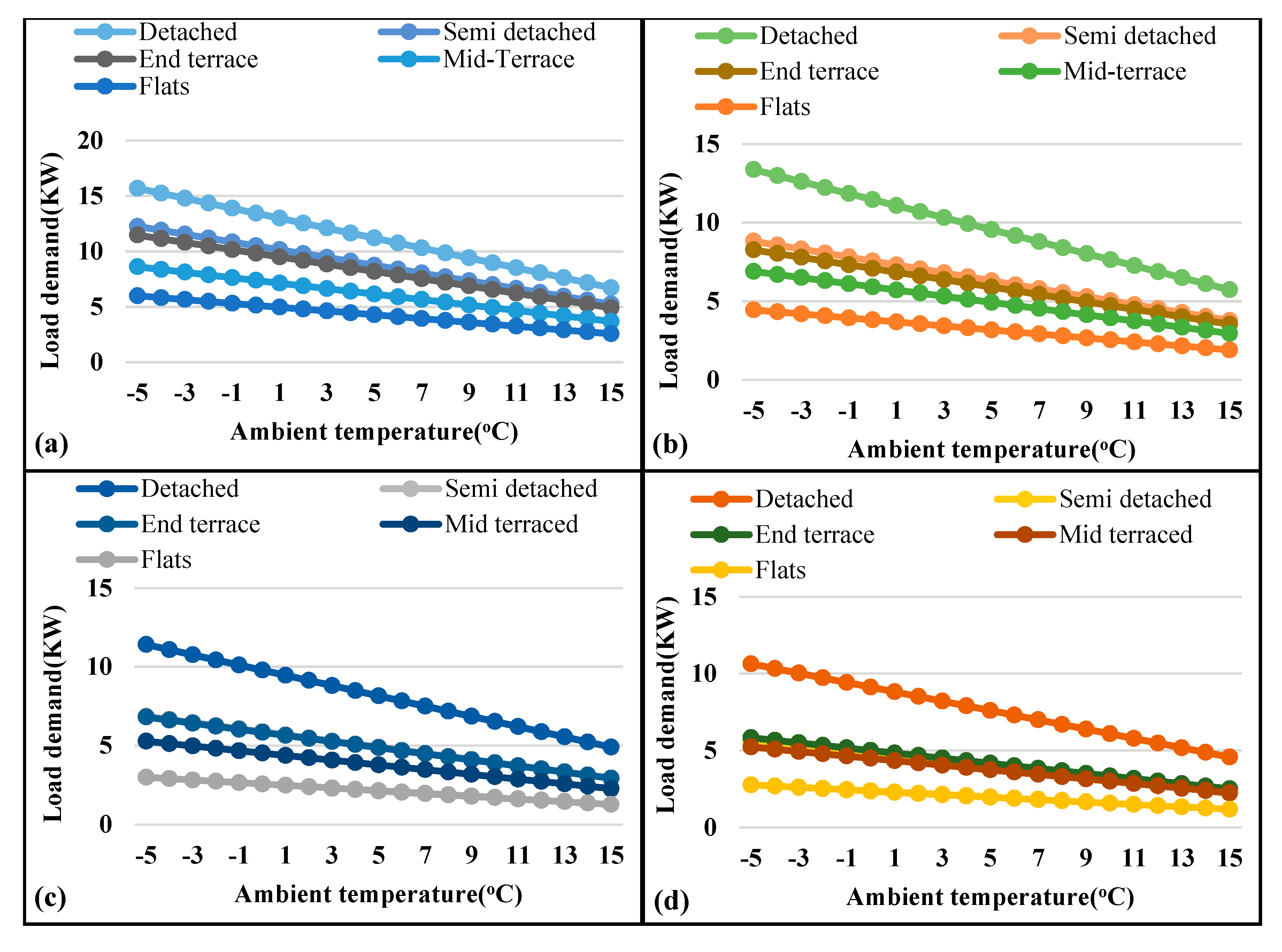

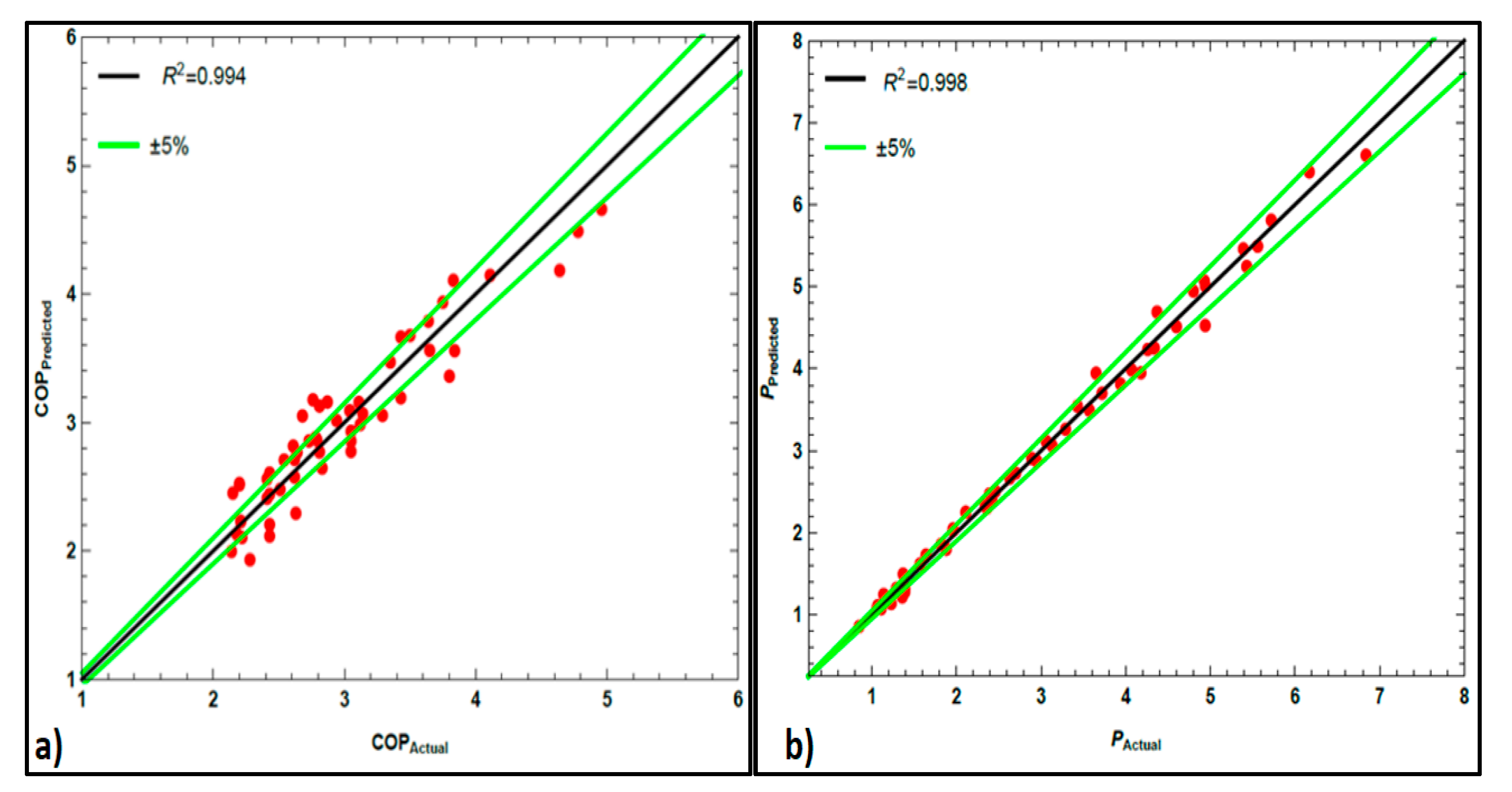
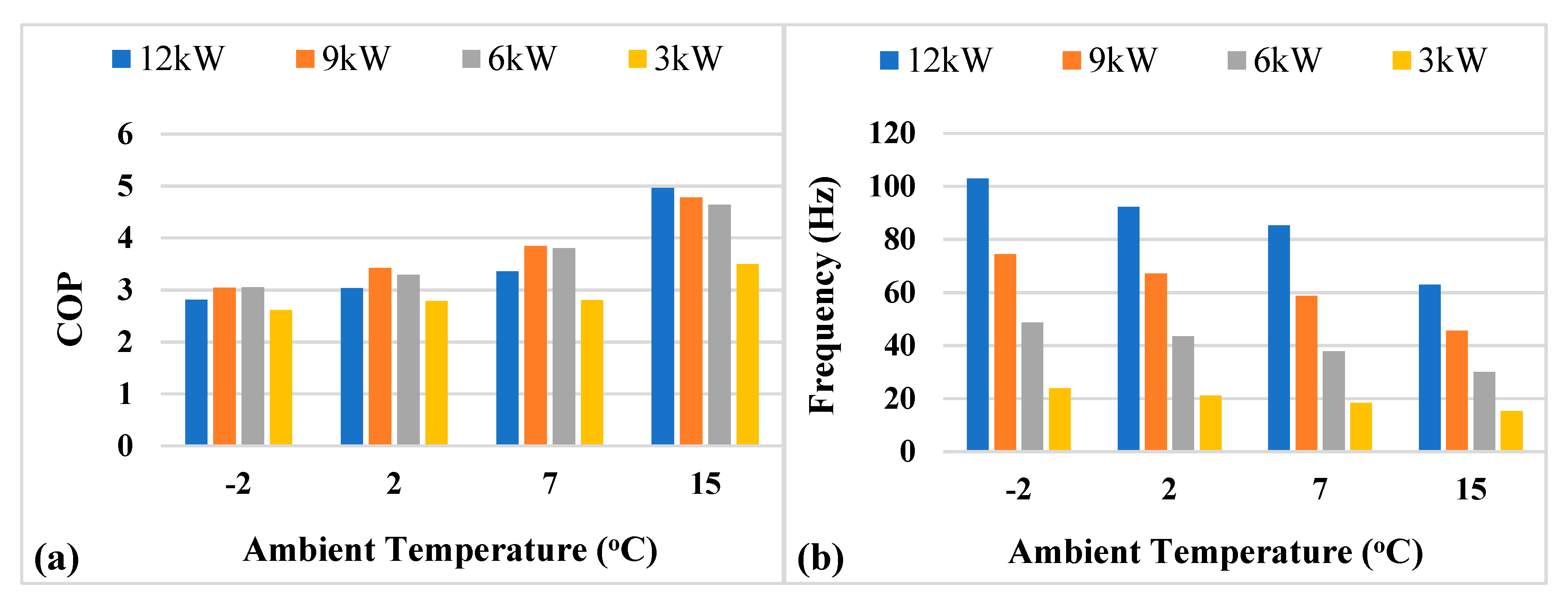
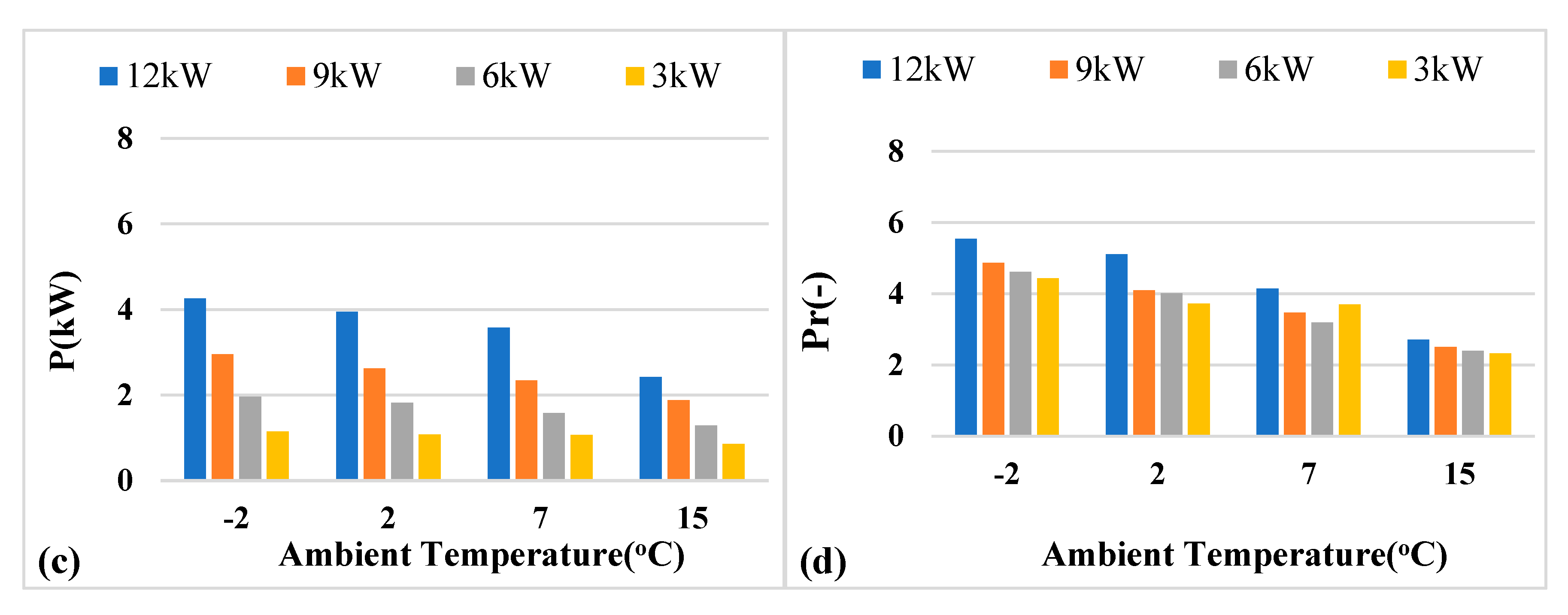
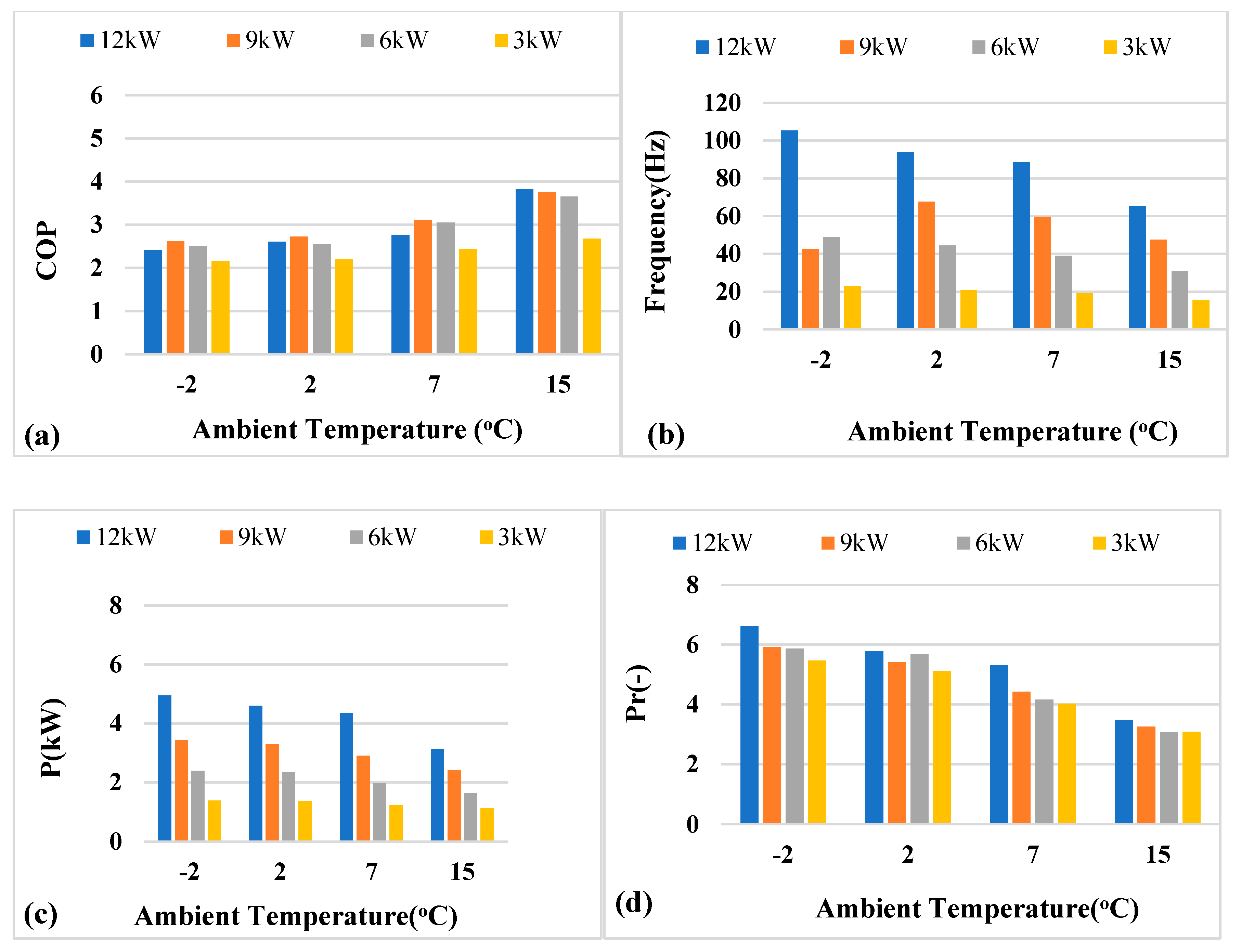
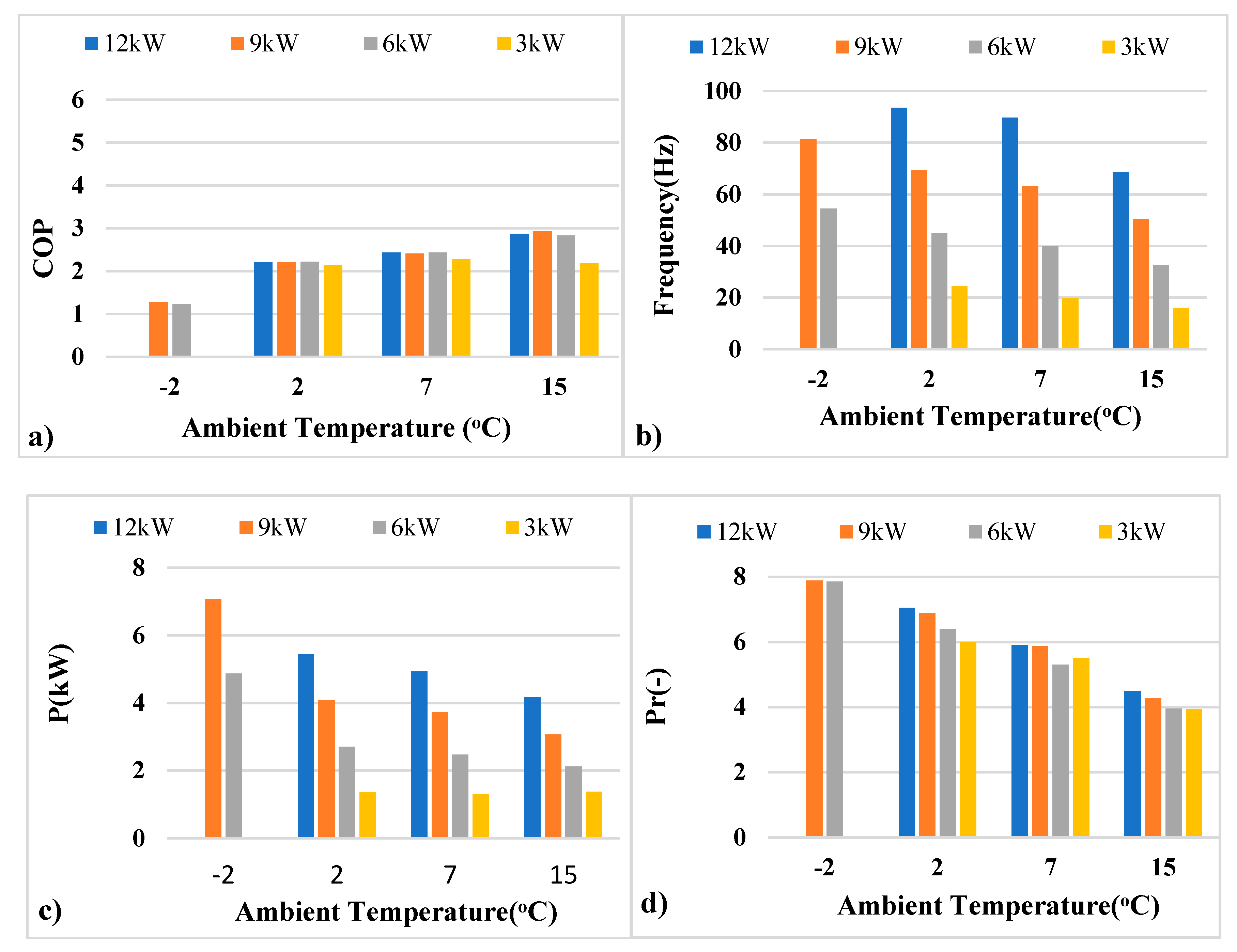
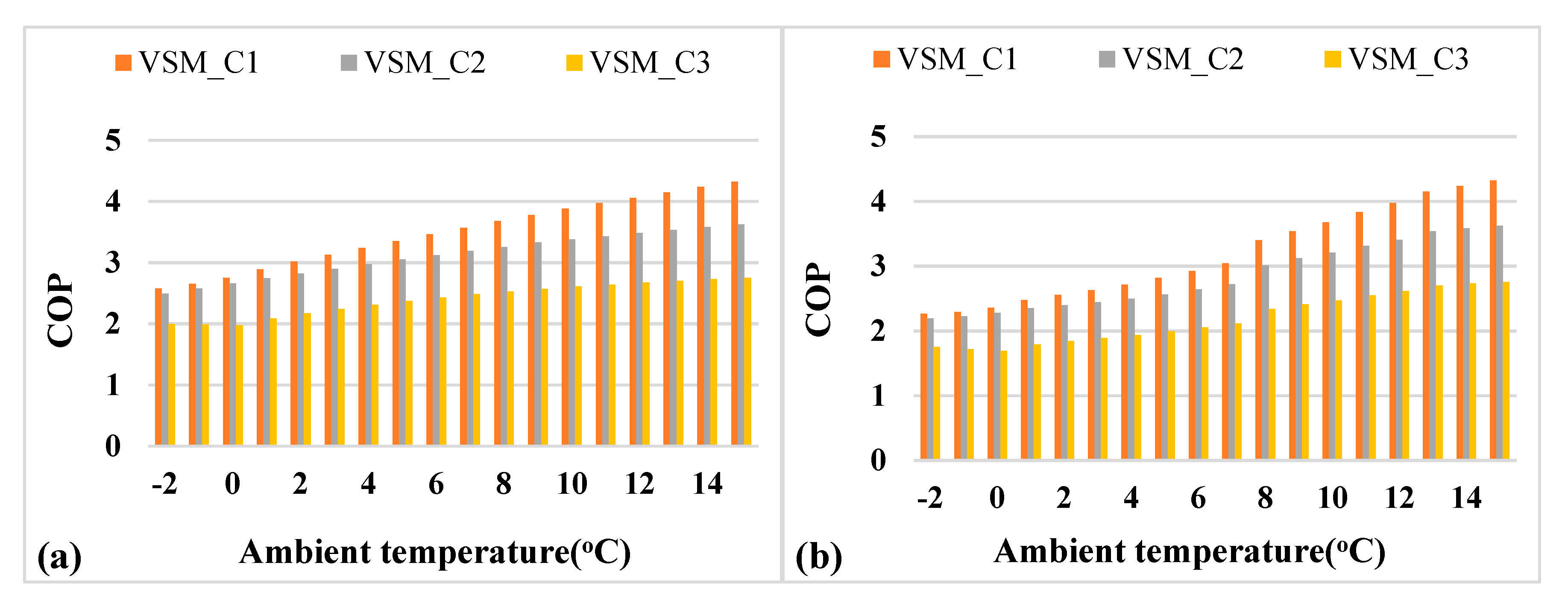
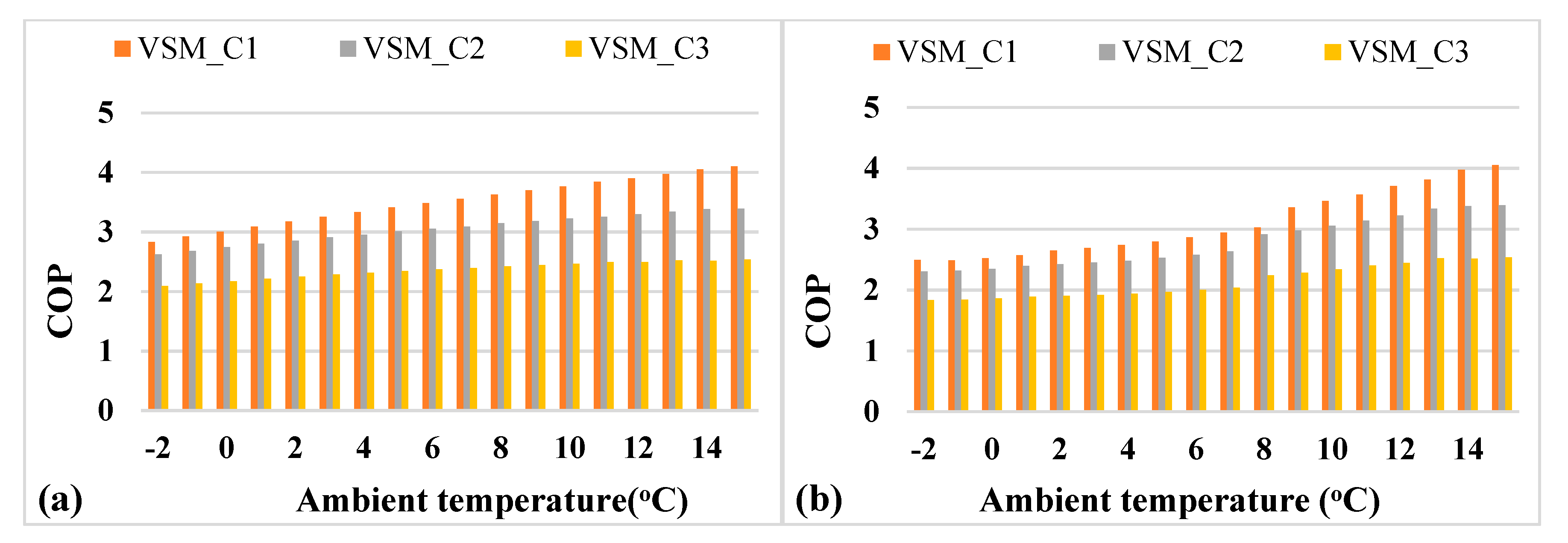
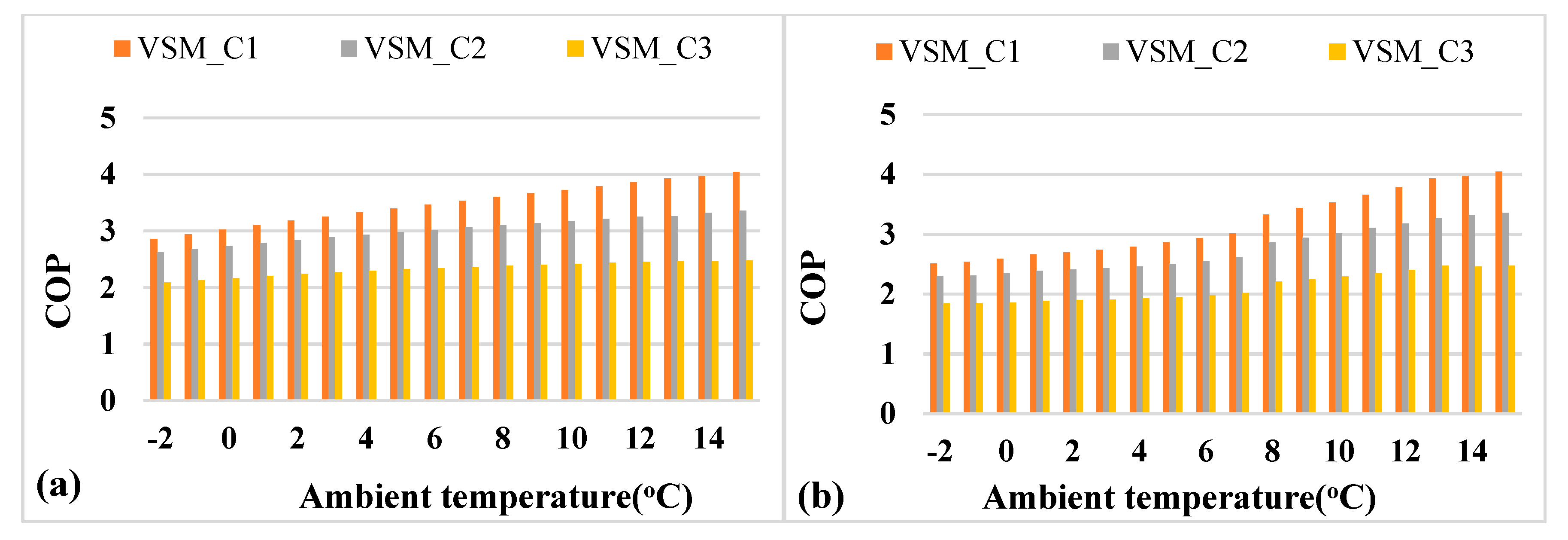



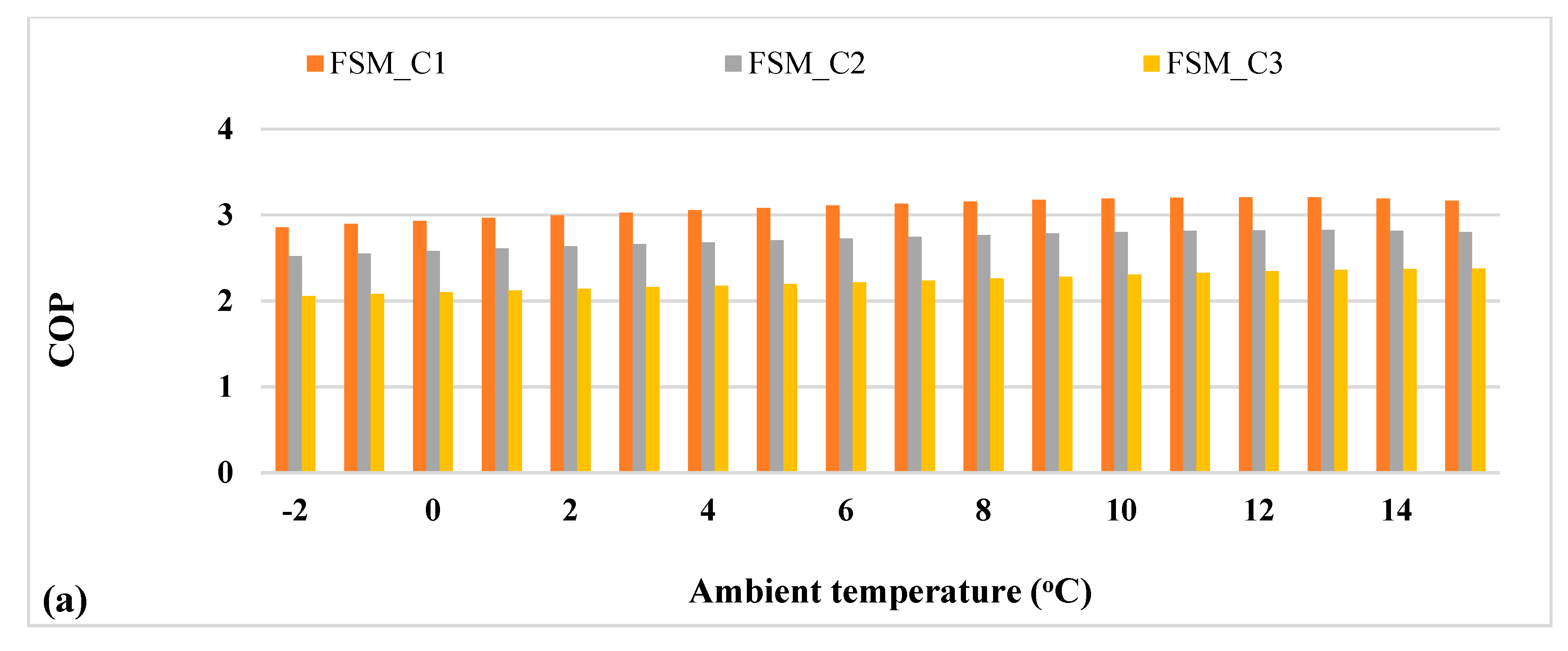
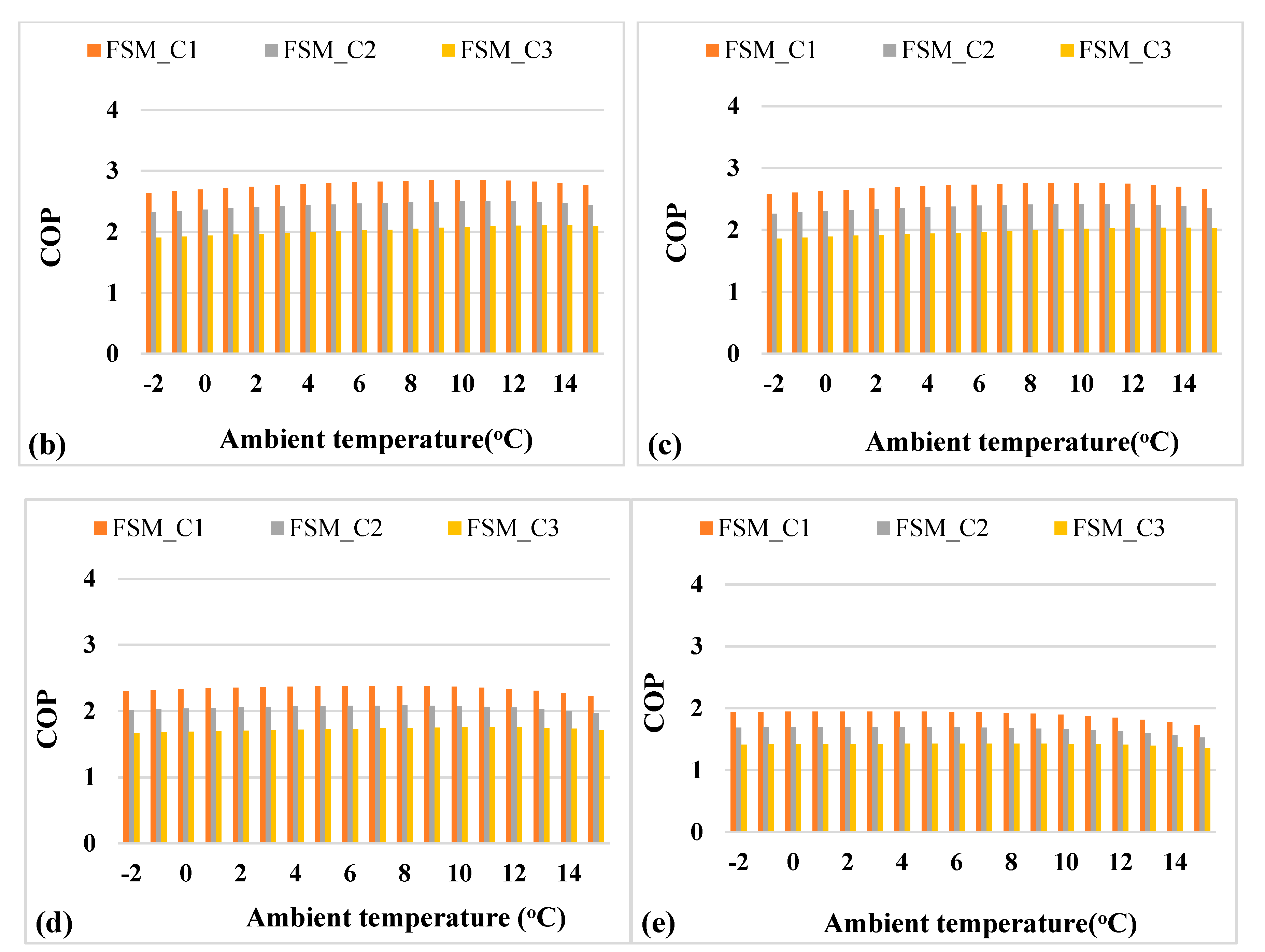
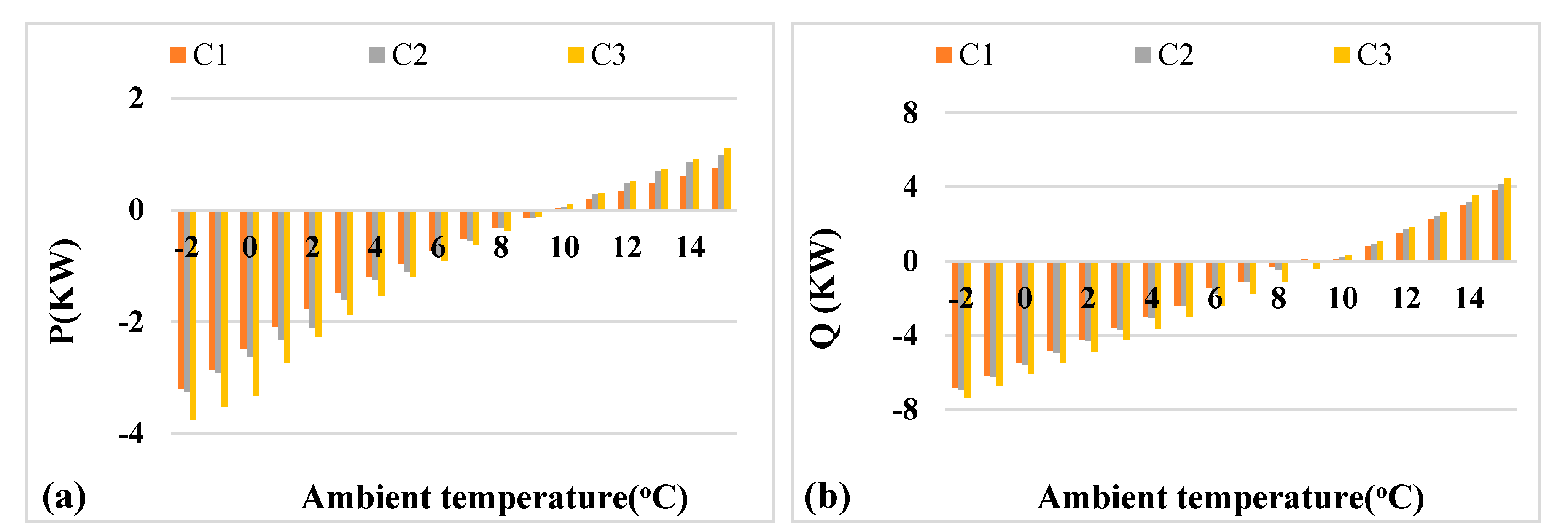
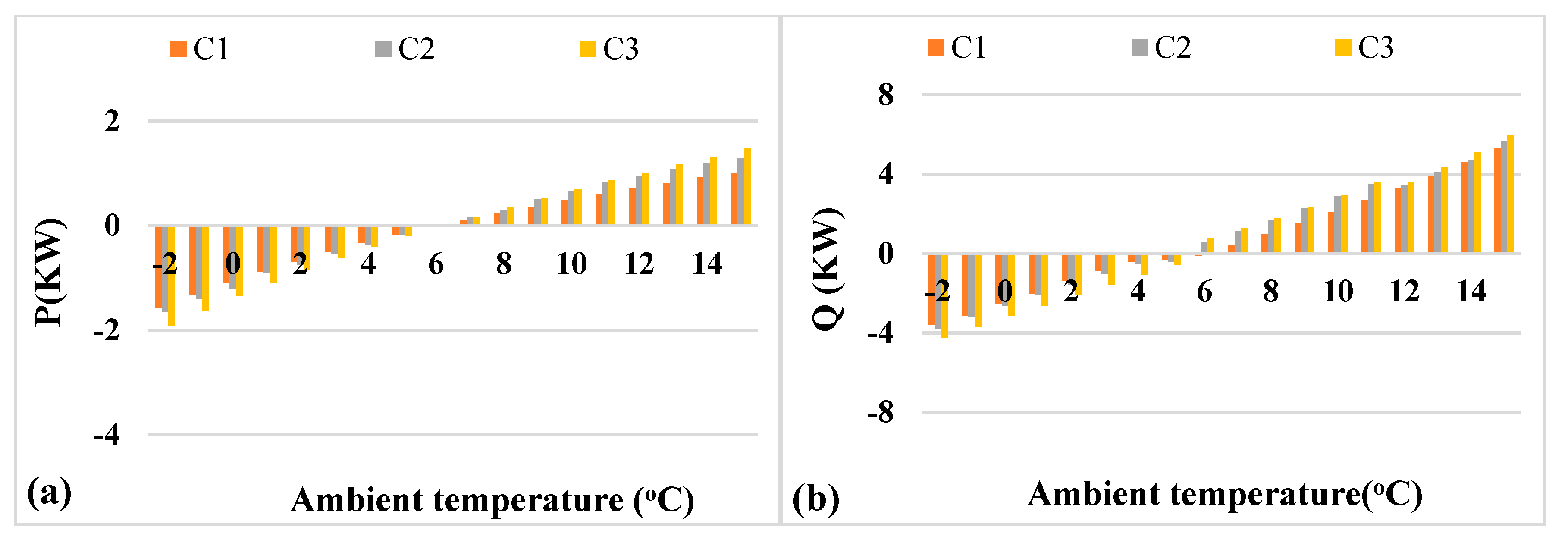
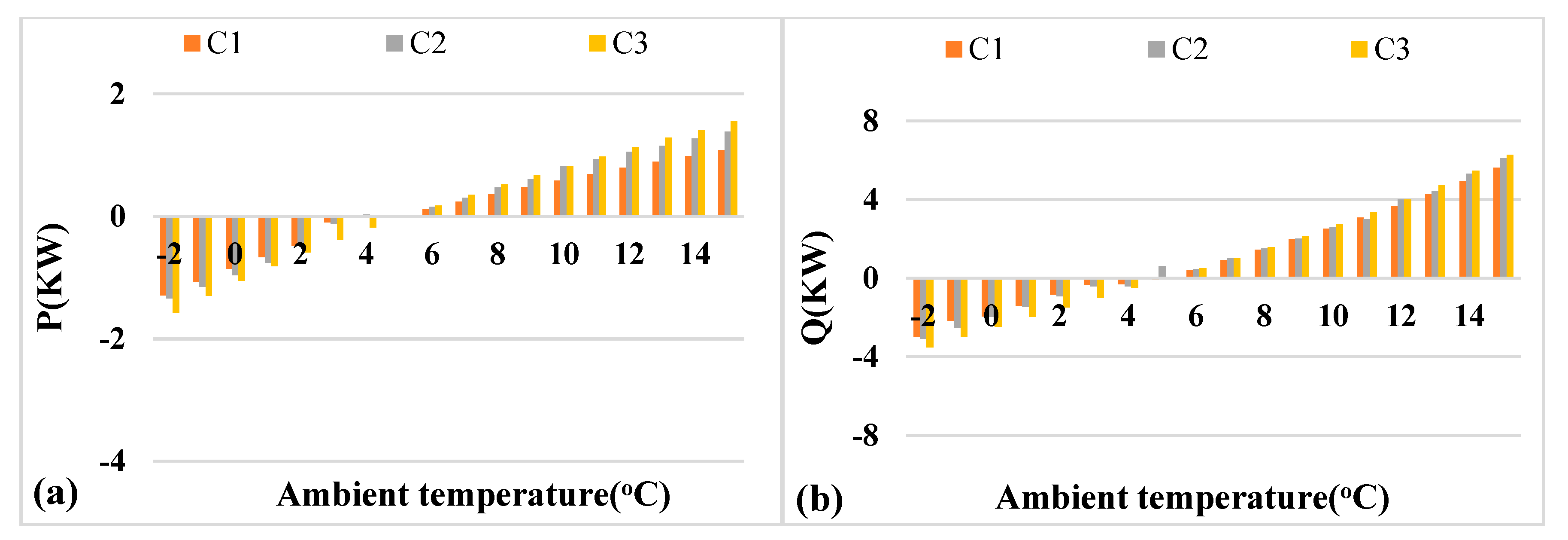
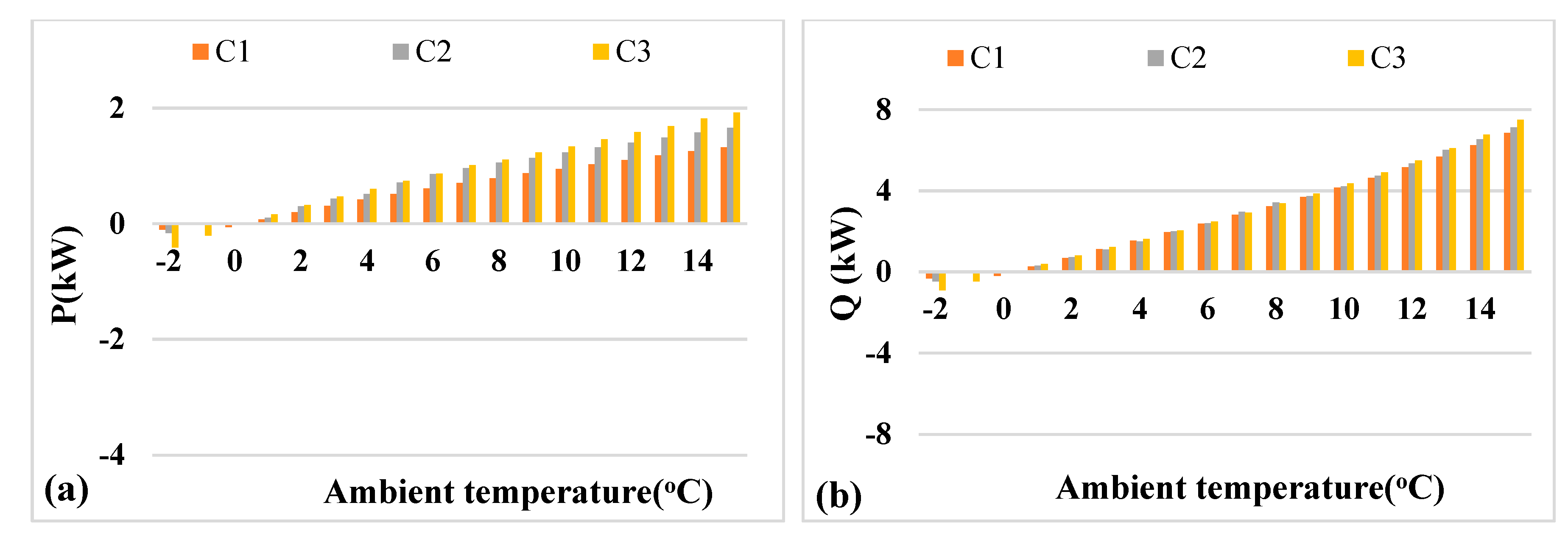
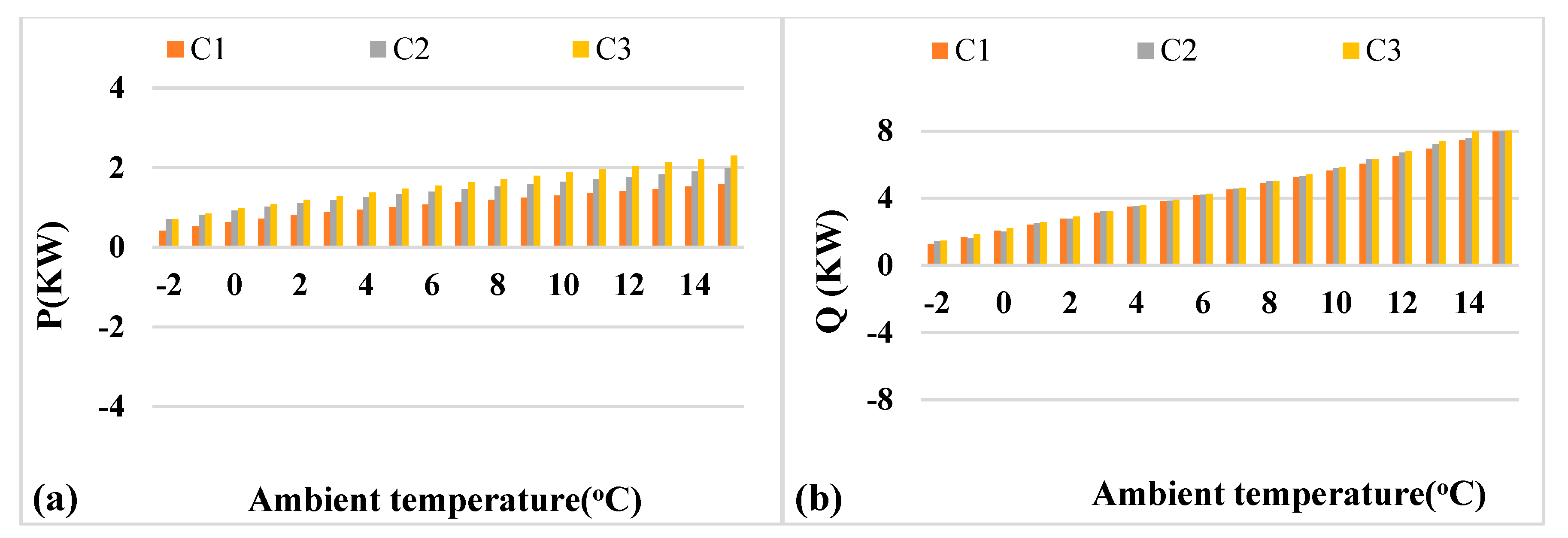
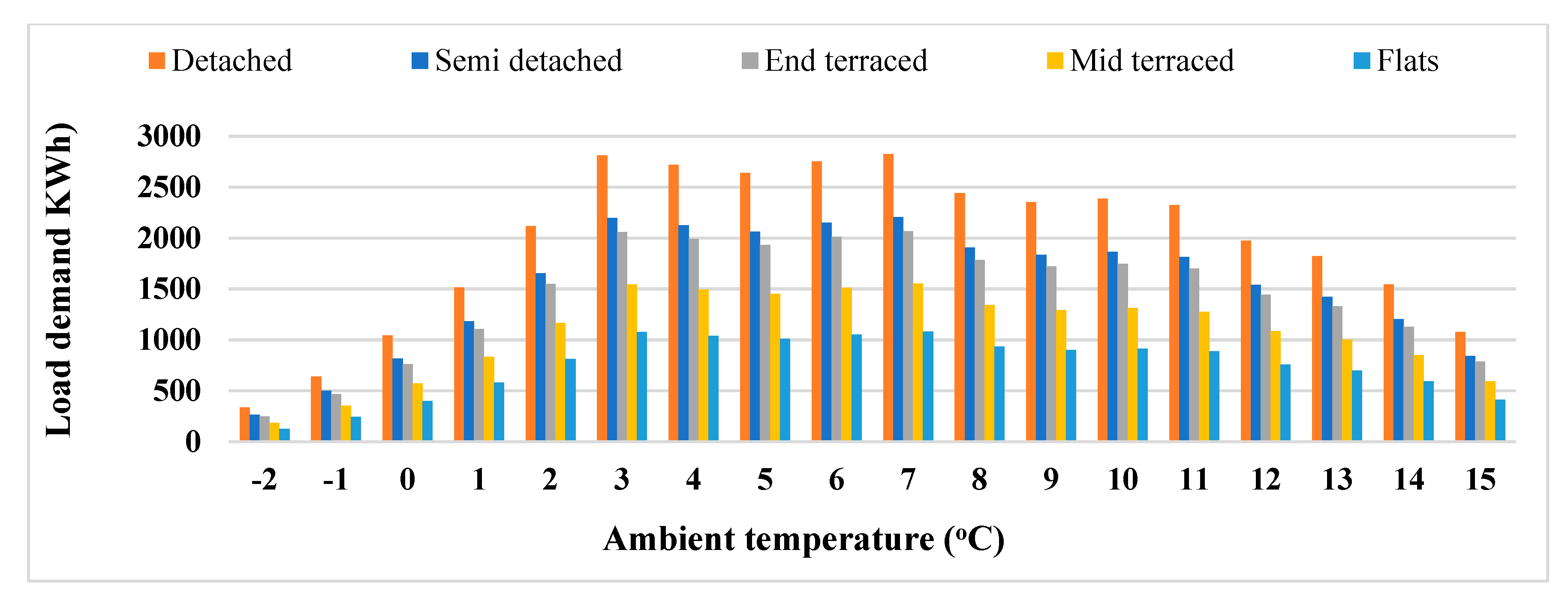

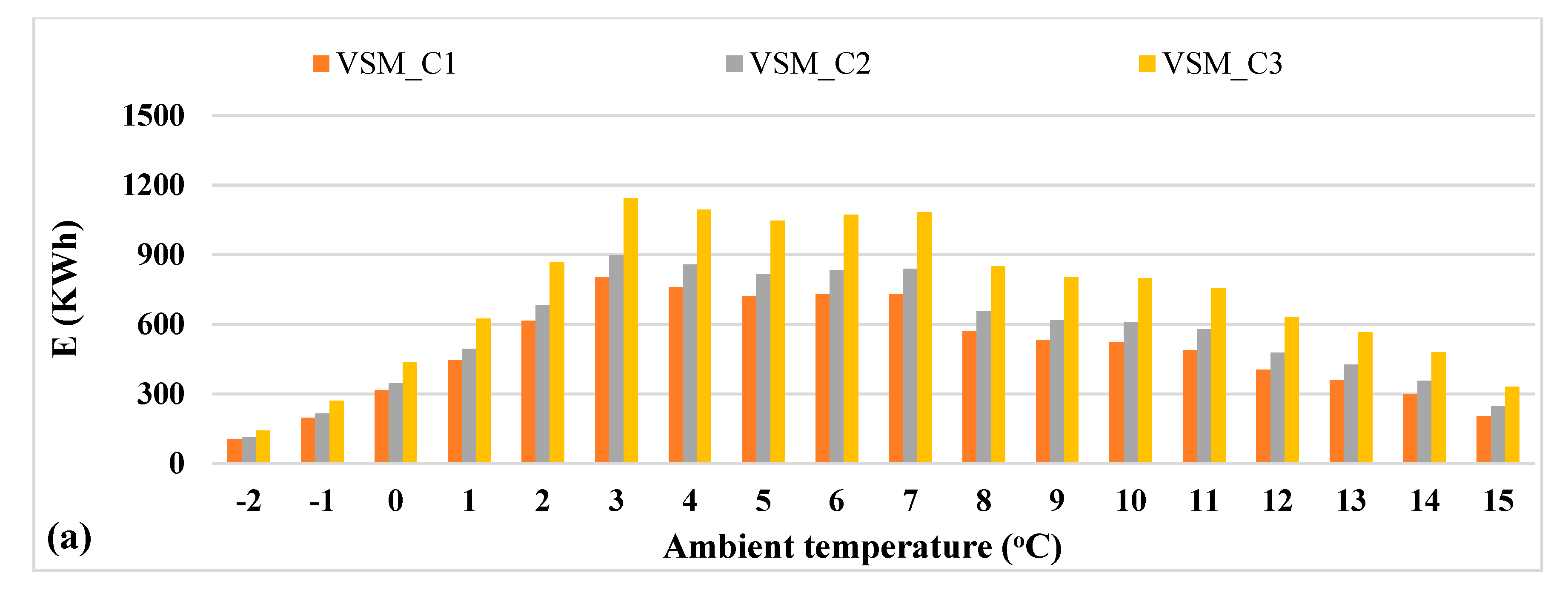
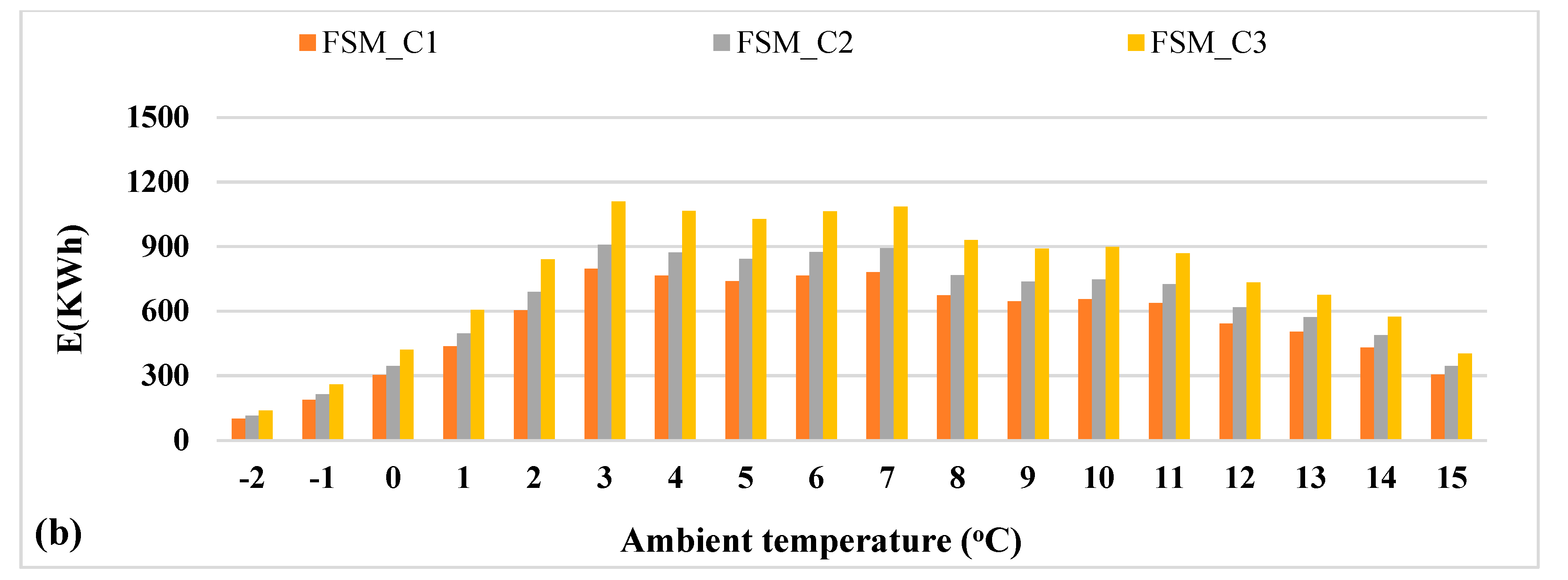
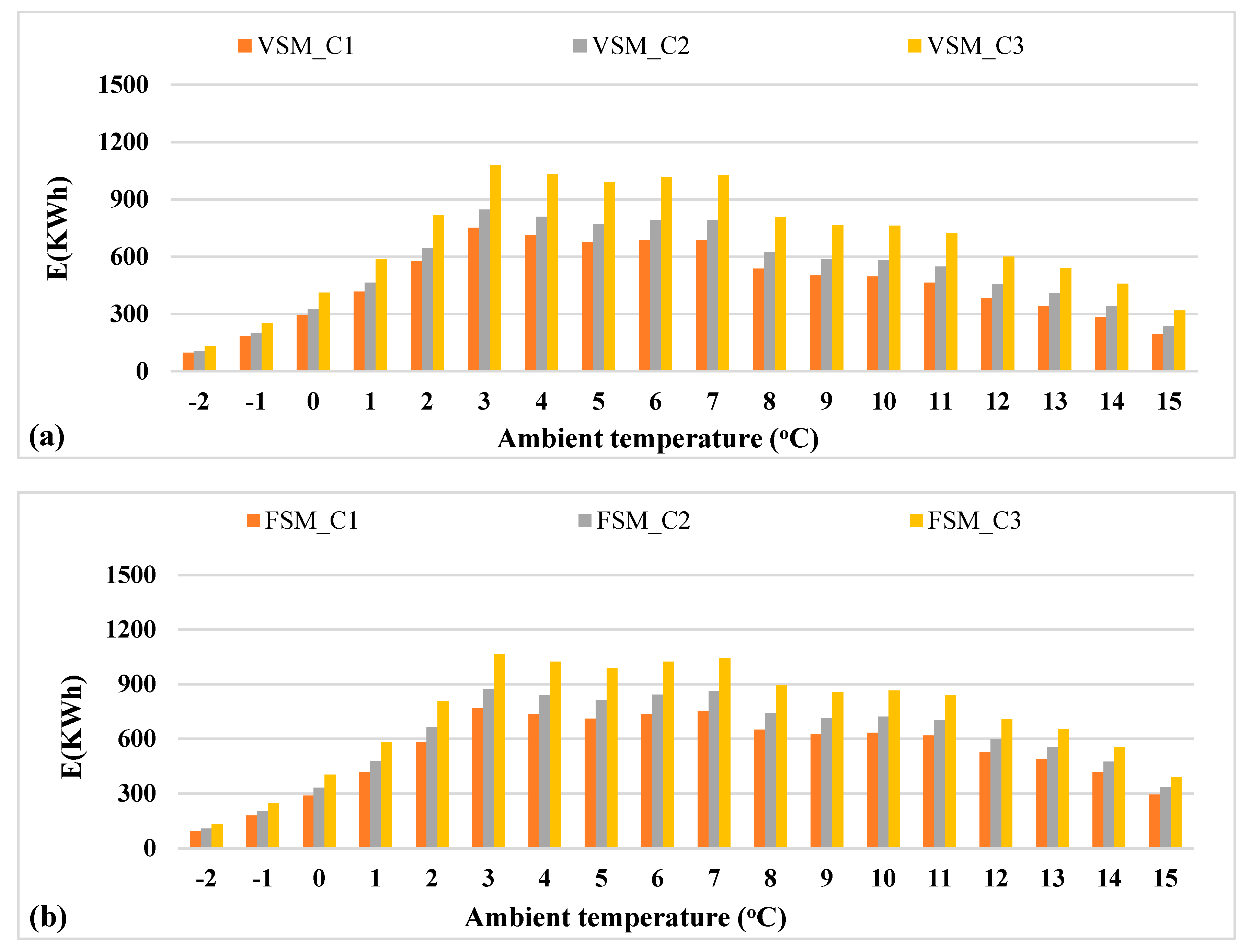
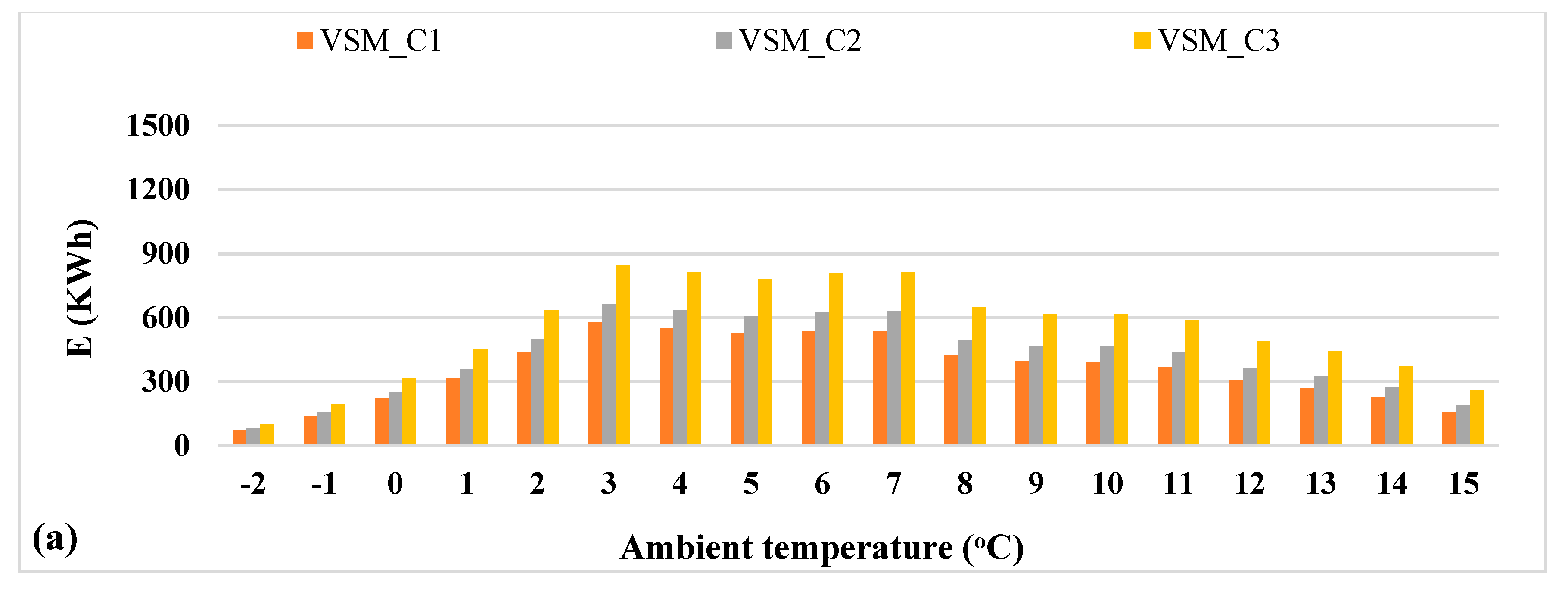
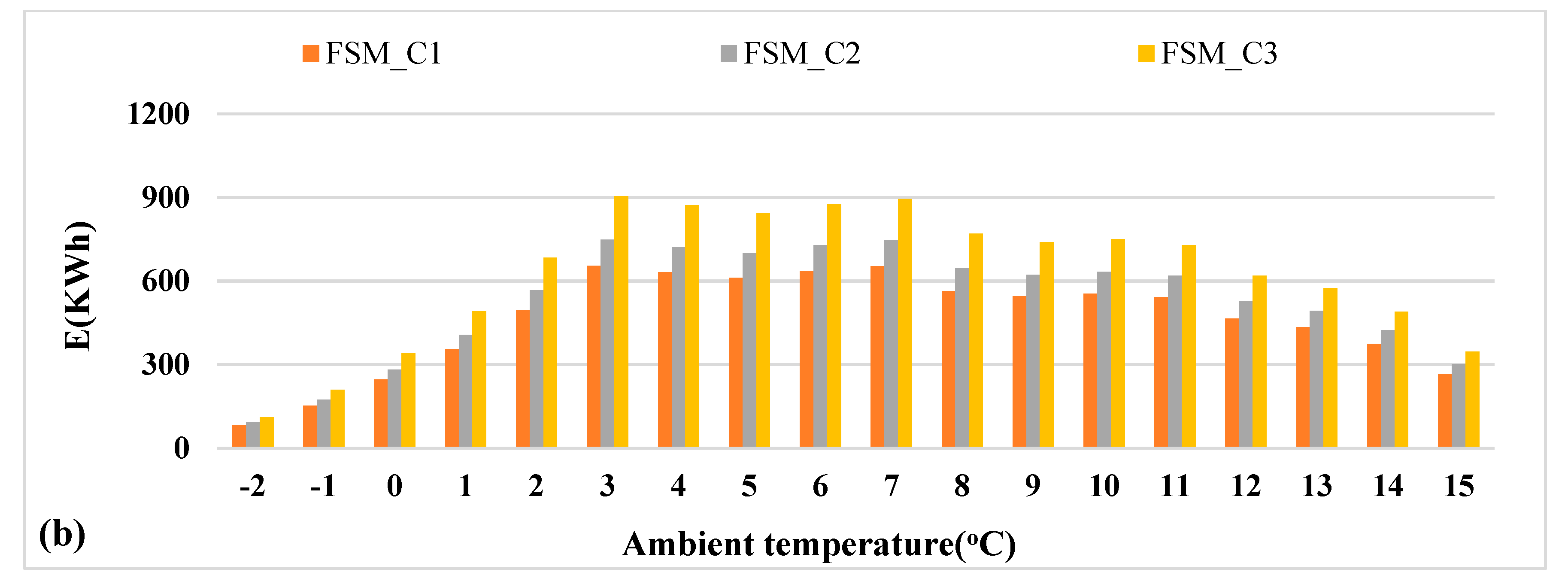
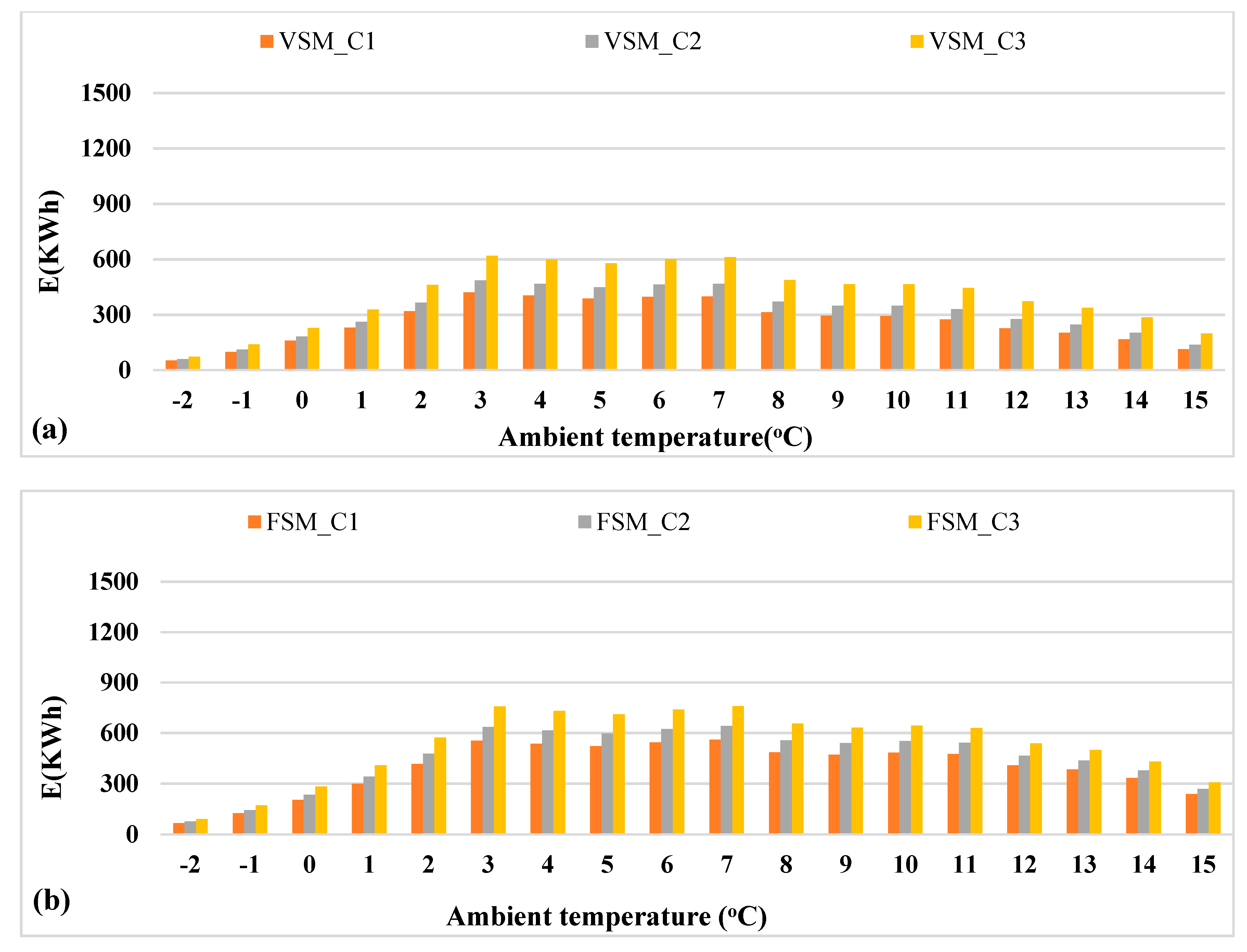

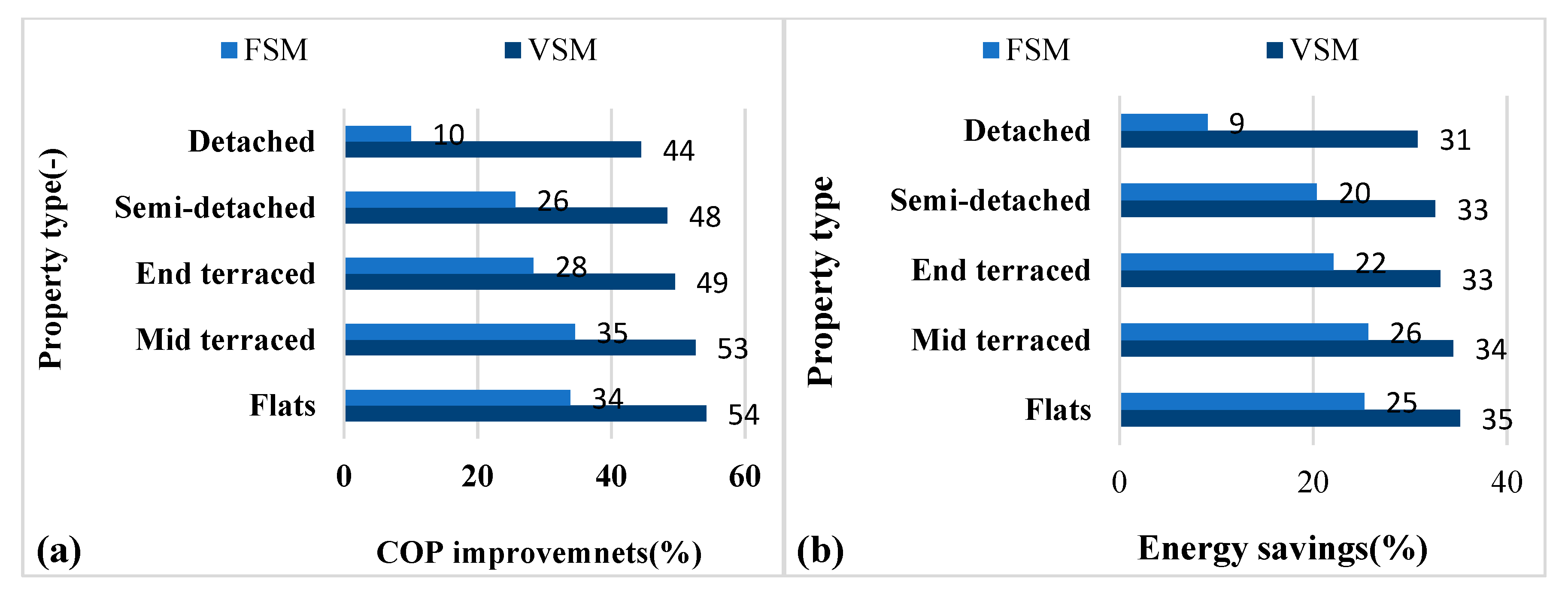
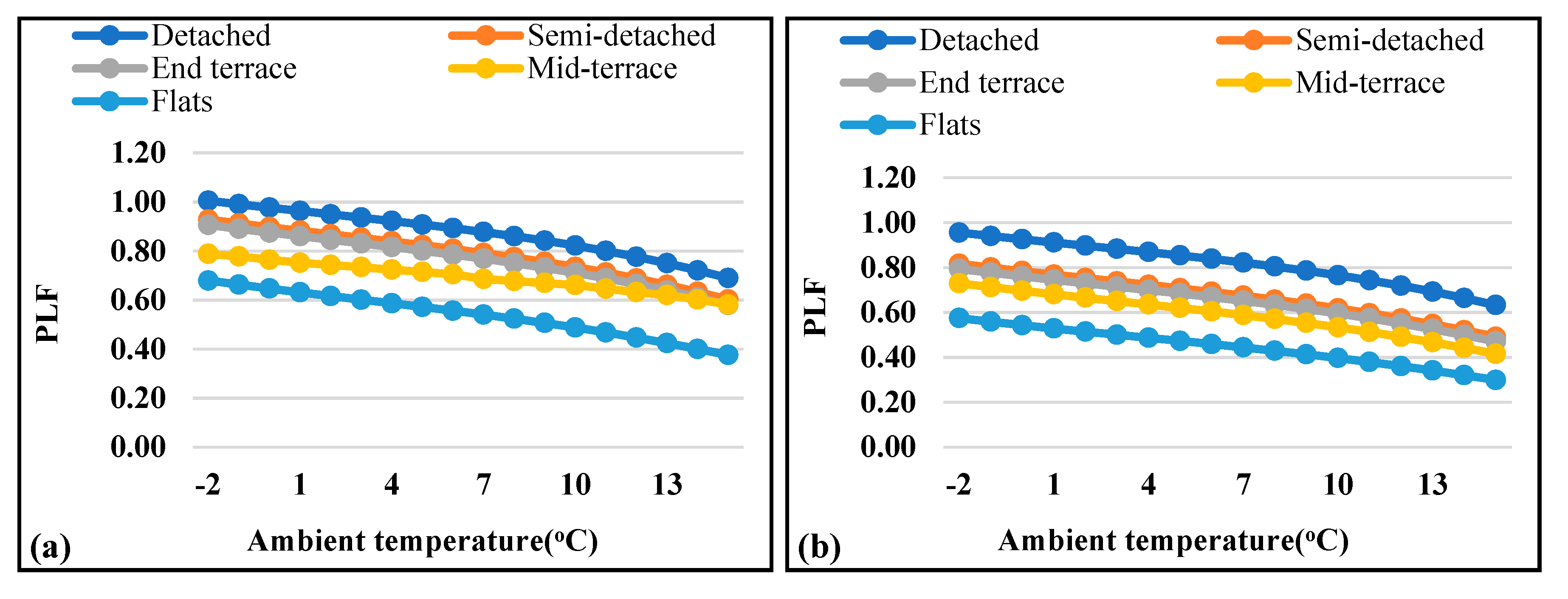
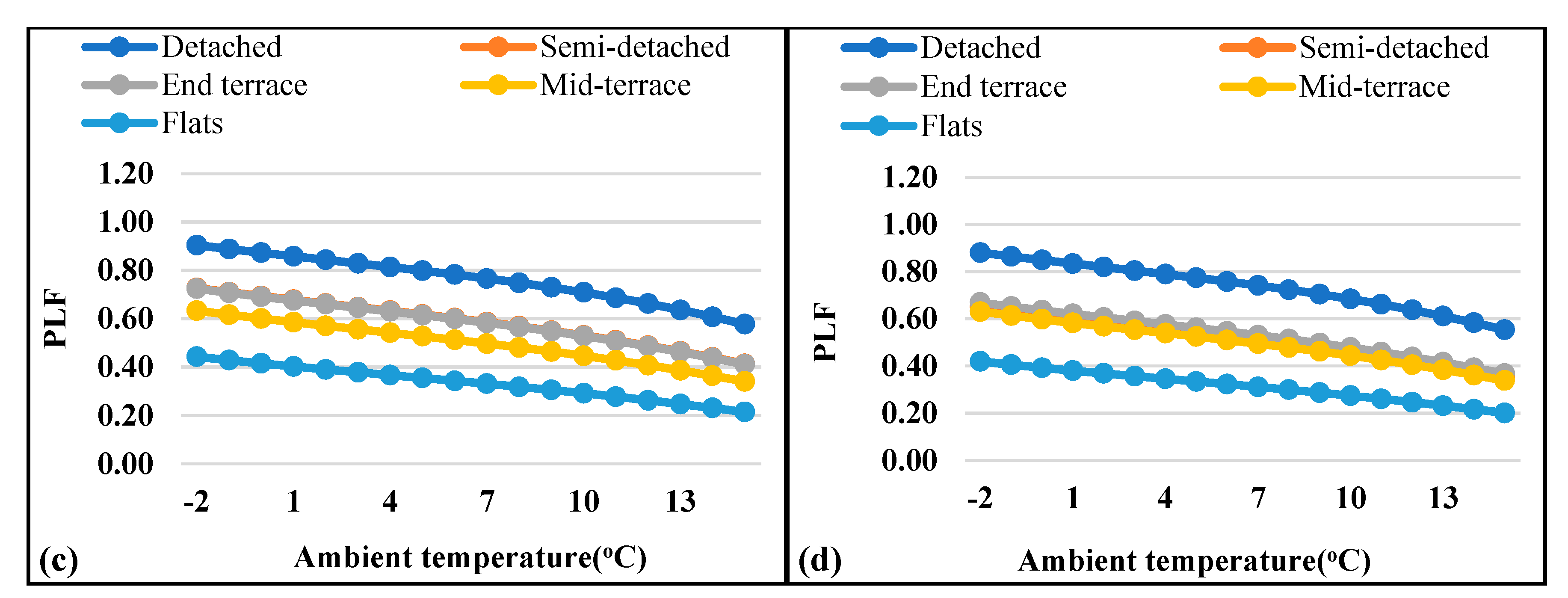
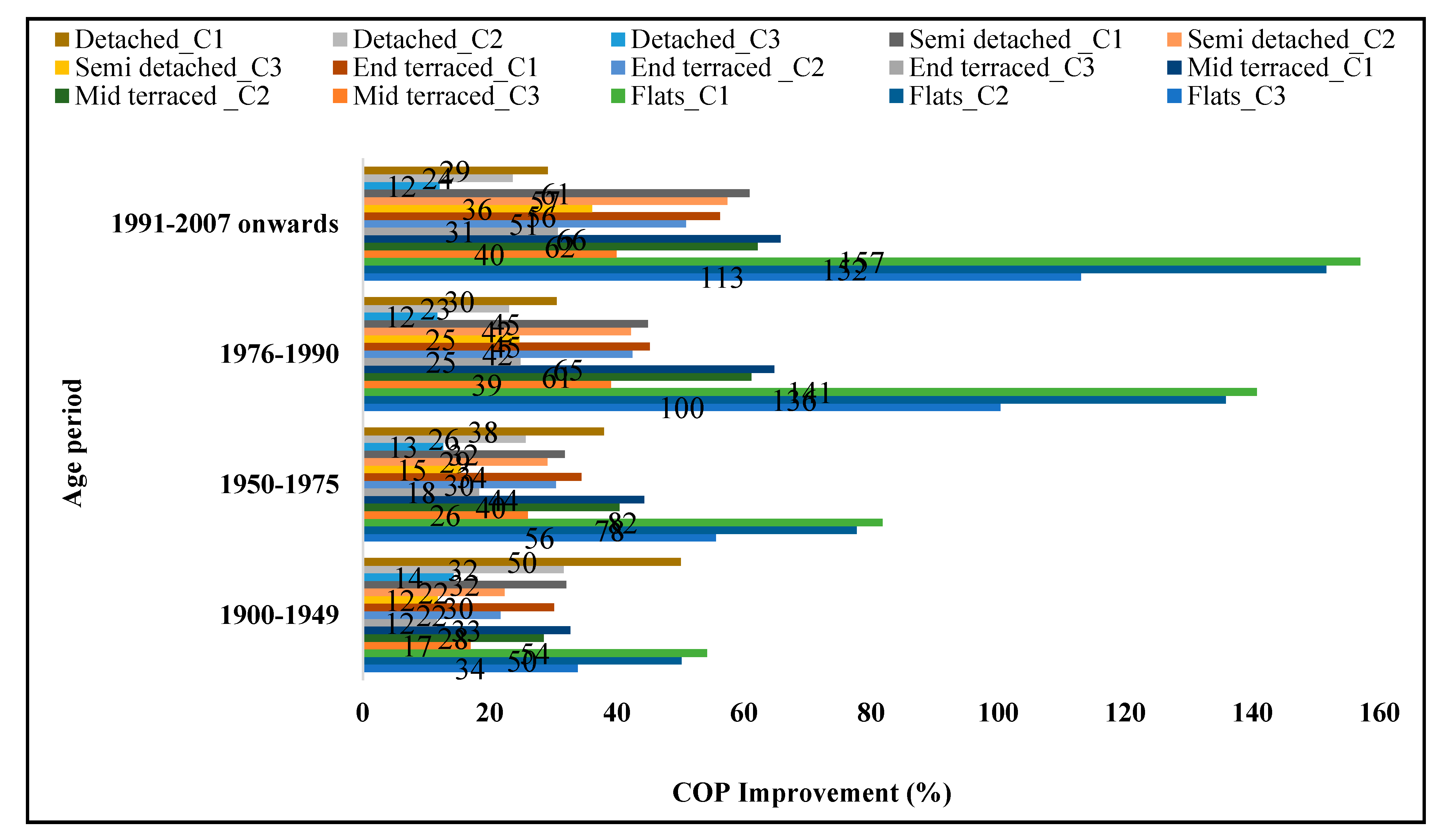

| Component Name | Model Number |
|---|---|
| Scroll compressor | XPV0302E-4 × 9 |
| Drive | ED3015B-H2XB–3 Phase for Variable Speed Compressors |
| Condenser | B80ASHx28/1P |
| Controller | Superheat and Envelope Controller—SEC MONO |
| Electronic expansion valve | EXL-BF1—Unipolar stepper motor valve |
| Converter | RS 485 |
| Temperature sensor | NTC (ECN-EG30) |
| Communication cable | SEC2-ED3-3W |
| Measured Quantity | Measurement Device | Units | Uncertainties | |
|---|---|---|---|---|
| Air side | Relative humidity (∅) | Hygrometer | - | ±0.8% |
| Dry bulb temperature (DB) | Thermocouple (T-type) | °C | ±2 | |
| Wet bulb temperature (WB) | Thermocouple (T-type) | °C | ±0.3 | |
| Refrigerant side | Mass flow rate | MASS 2100 DI15 | Kg/s | ±1.3% |
| Enthalpy (h) | Estimated from P and T measured values | kJ/kg | 1–1.76% | |
| Pressure (P) | PT5 pressure transmitters | kPa | ±1% | |
| Temperature (T) | NTC (ECN-EG30) | °C | ±0.5 | |
| Water side | Mass flow rate | Electromagnetic, Eltek, GC 62 | kg/s | ±1.5% |
| Pressure difference (static) | Pressure Gauge | Pa | ±5% | |
| Temperature inlet/outlet (T) | PT100, Eltek GD 24 | °C | ±0.1 | |
| Electric power meter | Landis and Gr P350 | W | ±1% | |
| Current | Transducers LEM AKR 50 C420L | A | ±0.5% | |
| Voltage | Transducers (ABB CC-U/V) | V | ±0.5% |
| Fixed Heating Capacities (kW) | Ambient Temp (°C) | DB (°C)/ WB (°C) | RH (%) | WST (°C) |
|---|---|---|---|---|
| 12, 9, 6, 3 | −2 | −2/−3 | 79.3 | 35, 45, 55 |
| 12, 9, 6, 3 | 2 | 2/1 | 83.9 | 35, 45, 55 |
| 15, 12, 9, 6, 3 | 7 | 7/6 | 86.9 | 30, 35, 40,45, 50,55 |
| 18, 15, 12, 9, 6, 3 | 15 | 15/14 | 90 | 30, 35, 40,45, 50, 55 |
| Building Type | Building Age Period | |
|---|---|---|
| Archetype | Flats | 1900–1949 |
| Mid-terraced | 1950–1975 | |
| End-terraced | 1976–1990 | |
| Semi-detached | 1991–2007 onwards | |
| Detached | ||
| No. of Archetype | 5 | 4 |
| Set Point | HC (kW) | (kg/s) | RH (%) | (Hz) | P (kW) | (−) | DLT (°C) | (%) | (%) | (%) | COP | ||
|---|---|---|---|---|---|---|---|---|---|---|---|---|---|
| 15 | 18 | 10.06 | 0.43 | 90.25 | 14.91 | 101.35 | 4.94 | 3.62 | 74.08 | 66.56 | 93.58 | 2.83 | 3.64 |
| 15 | 9.89 | 0.36 | 89.70 | 15.16 | 93.10 | 3.65 | 3.48 | 70.00 | 67.30 | 93.50 | 3.84 | 4.11 | |
| 12 | 9.95 | 0.29 | 91.18 | 15.19 | 62.87 | 2.42 | 2.71 | 59.07 | 72.13 | 95.03 | 5.80 | 4.96 | |
| 9 | 10.01 | 0.22 | 91.87 | 14.95 | 45.60 | 1.88 | 2.50 | 62.40 | 70.14 | 90.85 | 7.45 | 4.78 | |
| 6 | 10.08 | 0.14 | 89.34 | 15.11 | 30.04 | 1.29 | 2.39 | 58.83 | 67.88 | 84.78 | 10.86 | 4.64 | |
| 3 | 9.91 | 0.07 | 91.47 | 14.92 | 15.21 | 0.85 | 2.33 | 68.17 | 56.53 | 77.22 | 16.45 | 3.50 | |
| 7 | 15 | 9.97 | 0.36 | 89.14 | 6.90 | 107.69 | 4.80 | 4.53 | 77.97 | 63.68 | 88.96 | 2.92 | 3.12 |
| 12 | 9.99 | 0.29 | 88.37 | 6.82 | 85.27 | 3.57 | 4.14 | 71.98 | 65.86 | 89.03 | 3.92 | 3.35 | |
| 9 | 9.84 | 0.22 | 87.85 | 6.76 | 58.77 | 2.34 | 3.47 | 63.77 | 66.54 | 93.12 | 5.98 | 3.84 | |
| 6 | 9.86 | 0.14 | 87.91 | 6.79 | 37.78 | 1.57 | 3.19 | 65.60 | 68.08 | 83.61 | 8.89 | 3.80 | |
| 3 | 9.85 | 0.07 | 87.77 | 7.32 | 18.37 | 1.06 | 3.69 | 64.18 | 60.09 | 76.74 | 13.17 | 2.81 | |
| 2 | 12 | 9.89 | 0.29 | 85.67 | 2.12 | 92.25 | 3.94 | 5.10 | 74.98 | 62.21 | 82.49 | 3.55 | 3.04 |
| 9 | 9.98 | 0.22 | 87.04 | 2.13 | 67.19 | 2.63 | 4.10 | 67.42 | 66.22 | 89.96 | 5.33 | 3.43 | |
| 6 | 9.97 | 0.14 | 84.47 | 1.92 | 43.48 | 1.82 | 4.01 | 68.78 | 64.12 | 83.90 | 7.69 | 3.29 | |
| 3 | 9.85 | 0.07 | 86.10 | 2.19 | 21.10 | 1.07 | 3.72 | 63.81 | 59.39 | 70.00 | 13.07 | 2.79 | |
| −2 | 12 | 9.92 | 0.29 | 83.25 | −2.33 | 102.84 | 4.26 | 5.54 | 78.64 | 59.71 | 75.38 | 3.29 | 2.81 |
| 9 | 9.98 | 0.22 | 82.23 | −2.23 | 74.32 | 2.95 | 4.86 | 72.73 | 63.14 | 83.93 | 4.75 | 3.05 | |
| 6 | 10.03 | 0.14 | 82.52 | −2.22 | 48.64 | 1.96 | 4.60 | 70.27 | 63.04 | 79.23 | 7.13 | 3.05 | |
| 3 | 9.96 | 0.07 | 81.93 | −1.85 | 23.80 | 1.14 | 4.42 | 67.02 | 57.70 | 78.66 | 12.26 | 2.62 |
| Set Point (°C) | HC (kW) | (kg/s) | RH (%) | (Hz) | P (kW) | (−) | DLT (°C) | (%) | (%) | (%) | COP | ||
|---|---|---|---|---|---|---|---|---|---|---|---|---|---|
| 15 | 18 | 9.92 | 0.43 | 90.99 | 15.25 | 112.58 | 5.72 | 4.16 | 82.48 | 65.02 | 85.76 | 2.45 | 3.14 |
| 15 | 9.98 | 0.36 | 90.12 | 14.87 | 97.02 | 4.37 | 3.87 | 80.86 | 70.76 | 95.57 | 3.20 | 3.43 | |
| 12 | 9.93 | 0.29 | 91.54 | 14.87 | 65.27 | 3.13 | 3.46 | 73.32 | 71.36 | 95.51 | 4.48 | 3.83 | |
| 9 | 9.92 | 0.22 | 90.56 | 14.88 | 47.46 | 2.40 | 3.26 | 73.57 | 70.98 | 93.88 | 5.85 | 3.75 | |
| 6 | 9.89 | 0.14 | 89.27 | 14.88 | 30.99 | 1.64 | 3.06 | 75.75 | 68.14 | 88.93 | 8.56 | 3.65 | |
| 3 | 9.96 | 0.07 | 91.54 | 14.87 | 15.52 | 1.11 | 3.08 | 86.73 | 52.12 | 74.86 | 12.58 | 2.68 | |
| 7 | 15 | 9.85 | 0.36 | 88.07 | 6.82 | 108.33 | 5.56 | 5.42 | 87.90 | 61.65 | 88.69 | 2.52 | 2.64 |
| 12 | 9.97 | 0.29 | 88.22 | 7.71 | 88.50 | 4.34 | 5.32 | 88.39 | 64.09 | 89.31 | 3.23 | 2.76 | |
| 9 | 10.05 | 0.22 | 88.42 | 6.86 | 59.69 | 2.89 | 4.43 | 78.64 | 70.81 | 92.01 | 4.84 | 3.11 | |
| 6 | 9.86 | 0.14 | 88.68 | 6.83 | 38.95 | 1.96 | 4.15 | 80.86 | 68.86 | 88.43 | 7.13 | 3.05 | |
| 3 | 10.08 | 0.07 | 88.81 | 6.95 | 19.15 | 1.23 | 4.02 | 79.36 | 55.43 | 81.31 | 11.39 | 2.43 | |
| 2 | 12 | 9.97 | 0.29 | 86.46 | 2.10 | 93.84 | 4.60 | 5.78 | 88.89 | 61.24 | 93.61 | 3.04 | 2.61 |
| 9 | 9.88 | 0.22 | 88.78 | 2.18 | 67.64 | 3.29 | 5.42 | 87.86 | 65.69 | 89.64 | 4.25 | 2.73 | |
| 6 | 9.95 | 0.14 | 85.08 | 2.04 | 44.39 | 2.36 | 5.67 | 90.94 | 59.96 | 88.63 | 5.94 | 2.54 | |
| 3 | 8.92 | 0.07 | 85.97 | 2.08 | 20.79 | 1.36 | 5.12 | 96.52 | 50.10 | 69.56 | 10.31 | 2.20 | |
| −2 | 12 | 10.03 | 0.29 | 82.29 | −2.28 | 105.17 | 4.94 | 6.61 | 92.91 | 60.20 | 89.61 | 2.83 | 2.41 |
| 9 | 9.88 | 0.22 | 83.25 | −2.25 | 75.63 | 3.43 | 5.91 | 92.34 | 61.25 | 84.47 | 4.08 | 2.62 | |
| 6 | 9.93 | 0.14 | 80.43 | −2.23 | 48.83 | 2.39 | 5.87 | 90.96 | 60.93 | 78.67 | 5.86 | 2.51 | |
| 3 | 9.93 | 0.07 | 81.82 | −1.79 | 23.07 | 1.39 | 5.46 | 86.91 | 48.75 | 77.49 | 10.10 | 2.15 |
| Set Point (°C) | HC (kW) | RH (%) | (Hz) | P (kW) | (−) | DLT (°C) | (%) | (%) | (%) | COP | |||
|---|---|---|---|---|---|---|---|---|---|---|---|---|---|
| 15 | 18 | 10.02 | 0.43 | 92.61 | 14.92 | 114.23 | 6.84 | 4.95 | 97.53 | 64.69 | 85.49 | 2.05 | 2.63 |
| 15 | 9.96 | 0.36 | 91.23 | 14.81 | 97.42 | 5.39 | 4.73 | 95.63 | 67.65 | 93.44 | 2.60 | 2.78 | |
| 12 | 9.93 | 0.29 | 89.82 | 14.43 | 68.64 | 4.18 | 4.50 | 92.82 | 69.84 | 94.75 | 3.35 | 2.87 | |
| 9 | 9.88 | 0.22 | 91.10 | 14.61 | 50.52 | 3.06 | 4.26 | 91.70 | 69.58 | 90.46 | 4.58 | 2.94 | |
| 6 | 9.93 | 0.14 | 89.92 | 14.80 | 32.49 | 2.11 | 3.95 | 95.99 | 66.71 | 89.79 | 6.63 | 2.83 | |
| 3 | 9.88 | 0.07 | 91.78 | 14.89 | 15.97 | 1.38 | 3.93 | 112.82 | 46.32 | 71.30 | 10.14 | 2.18 | |
| 7 | 15 | 9.86 | 0.36 | 87.97 | 7.62 | 110.90 | 6.26 | 5.93 | 100.93 | 61.11 | 82.99 | 2.24 | 2.39 |
| 12 | 10.00 | 0.29 | 87.32 | 7.08 | 89.69 | 4.93 | 5.90 | 101.95 | 61.87 | 80.73 | 2.84 | 2.43 | |
| 9 | 10.06 | 0.22 | 89.13 | 6.20 | 63.22 | 3.72 | 5.86 | 100.25 | 63.65 | 89.13 | 3.76 | 2.41 | |
| 6 | 9.98 | 0.14 | 87.87 | 6.36 | 40.00 | 2.46 | 5.30 | 104.41 | 65.85 | 84.19 | 5.68 | 2.43 | |
| 3 | 9.96 | 0.07 | 88.21 | 6.59 | 19.85 | 1.31 | 5.50 | 108.01 | 49.86 | 72.06 | 10.72 | 2.28 | |
| 2 | 12 | 9.98 | 0.29 | 86.85 | 2.21 | 94.52 | 5.43 | 7.05 | 106.71 | 57.16 | 88.96 | 2.58 | 2.21 |
| 9 | 9.91 | 0.22 | 87.93 | 2.02 | 69.37 | 4.07 | 6.88 | 107.72 | 63.57 | 89.96 | 3.44 | 2.21 | |
| 6 | 9.97 | 0.14 | 85.45 | 1.88 | 44.83 | 2.70 | 6.39 | 107.62 | 61.69 | 84.91 | 5.19 | 2.22 | |
| 3 | 9.95 | 0.07 | 85.19 | 2.05 | 24.34 | 1.37 | 5.99 | 111.83 | 48.67 | 69.45 | 10.24 | 2.14 | |
| −2 | 9 | 9.91 | 0.22 | 81.69 | −2.23 | 81.25 | 7.07 | 7.88 | 101.54 | 54.73 | 79.50 | 1.98 | 1.27 |
| 6 | 9.79 | 0.14 | 81.93 | −2.22 | 54.53 | 4.87 | 7.85 | 102.46 | 56.03 | 76.15 | 2.88 | 1.23 |
| Property Type | Heat Output (KWh) | COP (VSM) | COP (FSM) | Electric Demand (KWh)_VSM | Electric Demand (KWh)_FSM | |||||||||
|---|---|---|---|---|---|---|---|---|---|---|---|---|---|---|
| C1 | C2 | C3 | C1 | C2 | C3 | C1 | C2 | C3 | C1 | C2 | C3 | EH | ||
| Flats | 14,564 | 2.89 | 2.46 | 1.87 | 1.87 | 1.64 | 1.40 | 5042 | 5912 | 7774 | 7774 | 8878 | 10,405 | 0 |
| Mid terrace | 20,914 | 3.05 | 2.61 | 2.00 | 2.30 | 2.03 | 1.71 | 6853 | 8008 | 10,457 | 9090 | 10,290 | 12,229 | 52 |
| End terrace | 27,846 | 3.16 | 2.75 | 2.12 | 2.43 | 2.26 | 1.90 | 8801 | 10,144 | 13,157 | 11,448 | 12,345 | 14,693 | 892 |
| Semi detached | 29,740 | 3.18 | 2.77 | 2.14 | 2.41 | 2.27 | 1.92 | 9356 | 10,726 | 13,884 | 12,353 | 13,120 | 15,516 | 1516 |
| Detached | 38,085 | 3.16 | 2.74 | 2.13 | 2.10 | 2.15 | 1.91 | 12,067 | 13,429 | 17,433 | 18,109 | 17,676 | 19,925 | 5333 |
| Control Mode (VSM vs. FSM)/Case Considered (C1 vs. C3) | Payback Period (-) | |
|---|---|---|
| VSM vs. FSM at 35 °C heat supply temperature (C1) | 358 | 2.8 |
| VSM vs. FSM at 55 °C heat supply temperature (C3) | 268 | 3.7 |
| Heating distribution installation cost (C1 vs. C3) in VSM | 675 | 8.9 |
| Heating distribution installation cost (C1 vs. C3) in FSM | 585 | 10.2 |
| Property Type | Age Period | Annual Heat Output (KWh) | COPS | Annual Electric Demand (KWh) | ||||||||||
|---|---|---|---|---|---|---|---|---|---|---|---|---|---|---|
| VSM | FSM | VSM | FSM | |||||||||||
| C1 | C2 | C3 | C1 | C2 | C3 | C1 | C2 | C3 | C1 | C2 | C3 | |||
| Flats | 1900–1949 | 14,564 | 2.89 | 2.46 | 1.87 | 1.87 | 1.64 | 1.40 | 5042 | 5912 | 7774 | 7774 | 8878 | 10,405 |
| 1950–1975 | 10,806 | 2.79 | 2.38 | 1.80 | 1.53 | 1.34 | 1.16 | 3878 | 4536 | 6009 | 7050 | 8061 | 9350 | |
| 1976–1990 | 7224 | 2.73 | 2.34 | 1.73 | 1.14 | 0.99 | 0.87 | 2642 | 3088 | 4164 | 6359 | 7281 | 8343 | |
| 1991–2007 | 6670 | 2.74 | 2.34 | 1.74 | 1.07 | 0.93 | 0.81 | 2433 | 2846 | 3843 | 6252 | 7161 | 8187 | |
| Mid-terraced | 1900–1949 | 20,914 | 3.05 | 2.61 | 2.00 | 2.30 | 2.03 | 1.71 | 6853 | 8008 | 10,457 | 9090 | 10,290 | 12,229 |
| 1950–1975 | 16,749 | 2.95 | 2.51 | 1.91 | 2.04 | 1.79 | 1.52 | 5684 | 6663 | 8747 | 8200 | 9354 | 11,021 | |
| 1976–1990 | 12,787 | 2.84 | 2.43 | 1.79 | 1.72 | 1.51 | 1.29 | 4510 | 5270 | 7125 | 7432 | 8492 | 9906 | |
| 1991–2007 | 12,671 | 2.83 | 2.43 | 1.80 | 1.71 | 1.50 | 1.28 | 4470 | 5221 | 7056 | 7409 | 8466 | 9873 | |
| End-terraced | 1900–1949 | 27,846 | 3.16 | 2.75 | 2.12 | 2.43 | 2.26 | 1.90 | 8801 | 10,144 | 13,157 | 11,448 | 12,345 | 14,693 |
| 1950–1975 | 20,069 | 3.03 | 2.59 | 1.98 | 2.26 | 1.99 | 1.68 | 6620 | 7742 | 10,126 | 8896 | 10,094 | 11,977 | |
| 1976–1990 | 16,516 | 2.94 | 2.53 | 1.88 | 2.03 | 1.78 | 1.51 | 5618 | 6531 | 8779 | 8154 | 9303 | 10,955 | |
| 1991–2007 | 14,127 | 2.87 | 2.43 | 1.80 | 1.84 | 1.61 | 1.37 | 4923 | 5821 | 7867 | 7690 | 8783 | 10,283 | |
| Semi-detached | 1900–1949 | 29,740 | 3.18 | 2.77 | 2.14 | 2.41 | 2.27 | 1.92 | 9356 | 10,726 | 13,884 | 12,353 | 13,120 | 15,516 |
| 1950–1975 | 21,409 | 3.06 | 2.66 | 2.00 | 2.32 | 2.06 | 1.73 | 6993 | 8061 | 10,727 | 9215 | 10,404 | 12,380 | |
| 1976–1990 | 16,632 | 2.95 | 2.54 | 1.89 | 2.03 | 1.78 | 1.51 | 5644 | 6560 | 8815 | 8177 | 9328 | 10,988 | |
| 1991–2007 | 13,370 | 2.85 | 2.44 | 1.81 | 1.77 | 1.55 | 1.33 | 4690 | 5476 | 7399 | 7544 | 8618 | 10,070 | |
| Detached | 1900–1949 | 38,085 | 3.16 | 2.84 | 2.18 | 2.10 | 2.15 | 1.91 | 12,067 | 13,429 | 17,433 | 18,109 | 17,676 | 19,925 |
| 1950–1975 | 32,449 | 3.19 | 2.83 | 2.18 | 2.31 | 2.25 | 1.93 | 10,179 | 11,467 | 14,910 | 14,043 | 14,402 | 16,795 | |
| 1976–1990 | 27,701 | 3.16 | 2.78 | 2.12 | 2.42 | 2.26 | 1.89 | 8761 | 9975 | 13,097 | 11,432 | 12,268 | 14,630 | |
| 1991–2007 | 25,807 | 3.14 | 2.75 | 2.08 | 2.43 | 2.22 | 1.86 | 8219 | 9392 | 12,379 | 10,613 | 11,605 | 13,876 | |
Publisher’s Note: MDPI stays neutral with regard to jurisdictional claims in published maps and institutional affiliations. |
© 2021 by the authors. Licensee MDPI, Basel, Switzerland. This article is an open access article distributed under the terms and conditions of the Creative Commons Attribution (CC BY) license (https://creativecommons.org/licenses/by/4.0/).
Share and Cite
Abid, M.; Hewitt, N.; Huang, M.-J.; Wilson, C.; Cotter, D. Performance Analysis of the Developed Air Source Heat Pump System at Low-to-Medium and High Supply Temperatures for Irish Housing Stock Heat Load Applications. Sustainability 2021, 13, 11753. https://doi.org/10.3390/su132111753
Abid M, Hewitt N, Huang M-J, Wilson C, Cotter D. Performance Analysis of the Developed Air Source Heat Pump System at Low-to-Medium and High Supply Temperatures for Irish Housing Stock Heat Load Applications. Sustainability. 2021; 13(21):11753. https://doi.org/10.3390/su132111753
Chicago/Turabian StyleAbid, Muhammad, Neil Hewitt, Ming-Jun Huang, Christopher Wilson, and Donal Cotter. 2021. "Performance Analysis of the Developed Air Source Heat Pump System at Low-to-Medium and High Supply Temperatures for Irish Housing Stock Heat Load Applications" Sustainability 13, no. 21: 11753. https://doi.org/10.3390/su132111753
APA StyleAbid, M., Hewitt, N., Huang, M.-J., Wilson, C., & Cotter, D. (2021). Performance Analysis of the Developed Air Source Heat Pump System at Low-to-Medium and High Supply Temperatures for Irish Housing Stock Heat Load Applications. Sustainability, 13(21), 11753. https://doi.org/10.3390/su132111753





